4/01/2023 Columbia Gorge (link to here)

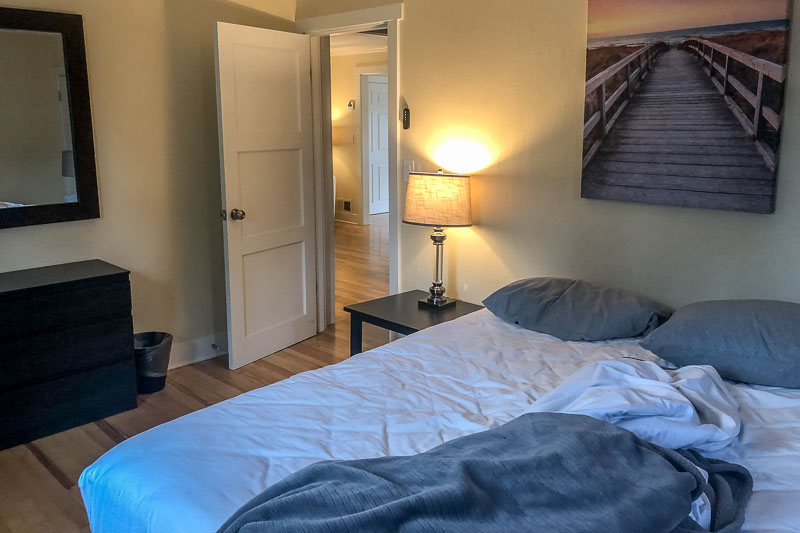
 Happy Sabbath! Or for those who are otherwise inclined, Happy April Fools' Day! We did not recall
that today was April Fools' Day but we remembered Sabbath by enjoying the dramatic scenery and
varied birds of the central Columbia Gorge while Richard and Donna joined a momentous reunion of the
Columbia Academy class of 1973. Richard was one of the class sponsors and an honored guest at the
reunion. We all spent last night together at an attractive and comfortable AirBnB a mile or so east
of downtown Vancouver. Darchelle's parents had already eaten by the time we arrived so Darchelle
fed me beer (unfortunately not Even More Jesus!) and cheese then studied checklists on her
phone while Richard and I discussed Desmond Ford.
Happy Sabbath! Or for those who are otherwise inclined, Happy April Fools' Day! We did not recall
that today was April Fools' Day but we remembered Sabbath by enjoying the dramatic scenery and
varied birds of the central Columbia Gorge while Richard and Donna joined a momentous reunion of the
Columbia Academy class of 1973. Richard was one of the class sponsors and an honored guest at the
reunion. We all spent last night together at an attractive and comfortable AirBnB a mile or so east
of downtown Vancouver. Darchelle's parents had already eaten by the time we arrived so Darchelle
fed me beer (unfortunately not Even More Jesus!) and cheese then studied checklists on her
phone while Richard and I discussed Desmond Ford.
Ford was an Adventist professor and theologian who, concerned about a widespread lack of assurance of salvation among Adventists in the 1960s, initially emphasized that the righteousness by faith which God requires refers only to justification - faith in the atoning death of Christ on the cross - and not also to sanctification - the perfection of character wrought in the believer by the Holy Spirit. Most Adventists today, if perhaps not back then, could accept that perspective but Ford went on to deny the sanctuary doctrine, the young age of the earth and other essential Adventist beliefs and for that he was evicted from the church. By most accounts he remained a gracious Christian man, but one who was not willing to forsake his own understanding of Scripture in order to accept the dictates of the church.
The prevailing Adventist belief at the time was that salvation required both justification and sanctification. Since one's own sanctification is difficult to discern, most Adventists doubted they would achieve sufficient sanctification, that is perfection of character, to be saved. As far as I can tell not much has changed, though perhaps today it is more common to largely ignore the whole question of salvation rather than to attempt to determine exactly how and whether it has been accomplished. As for myself I find it difficult to see what is good about the good news of a gospel in which all are justified but few end up qualified for heaven. Better news might be that heaven is open to all, and that we all will be transformed so as to not fuck up the place once we get there. If that is too much to ask then second best might be that after death we do not reawaken to either good or evil, reward or punishment. We just sleep with our fathers (and mothers) through eternity. But I digress.
Anticipating that we will be returning this summer, our focus today was on the Columbia River waterfront because most of the ducks will soon be headed north, and because it was raining and ducks don't mind rain. Bingen Pond L+ and Bingen Harbor L+ together gave us 9 new species, of which I missed a couple because the priority was getting birds for Darchelle.
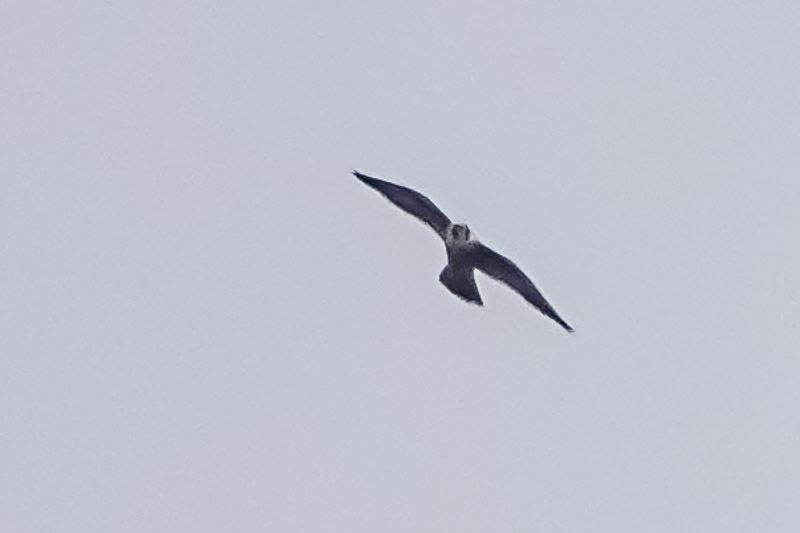
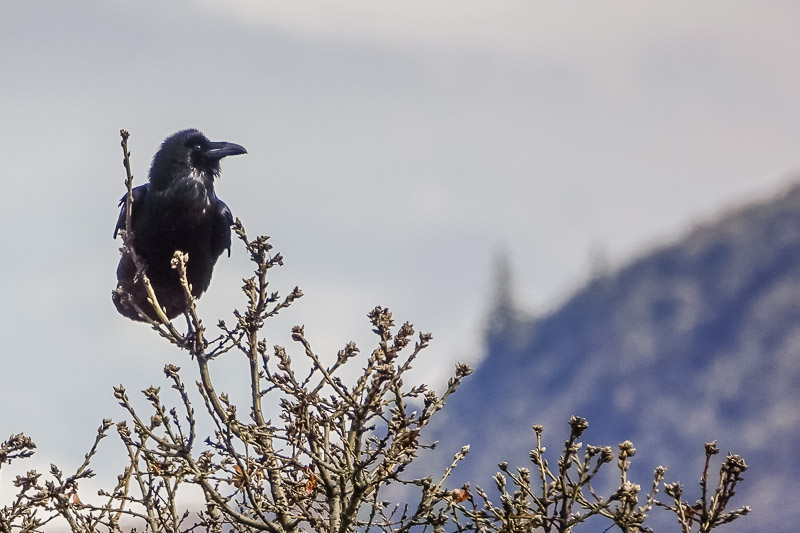
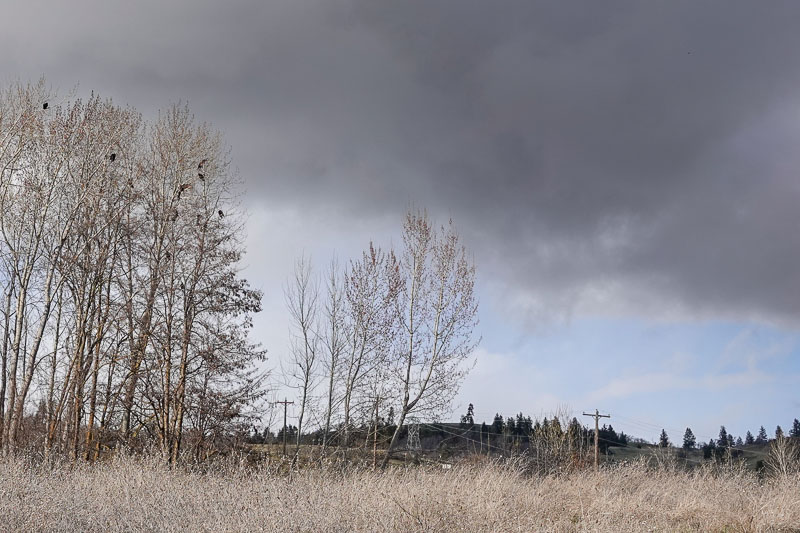 Continuing east we stopped at Locke
Lake L+ to play a Canyon Wren song, thinking the big cliff above the lake might host them. No
wren responded but as I was listening out my open window, I noticed a Raven soaring over the cliff
which turned into a large falcon as soon as it flapped its wings. I pointed it out to Darchelle who
got photos. As we were puzzling over the ID a man when a camera around his neck returned to his car
next to us and asked what we were looking at. His accent was British, his name Barney and it turned
out he was an Englishman living in Hood River. Darchelle showed him photos and he thought it might
be a Prairie but agreed a Peregrine was possible, then asked if we knew about the Klickitat River
mouth, another good spot for hawks. When we dithered Barney offered to drive us there and because
he seemed like such a nice guy, we agreed to follow him.
Continuing east we stopped at Locke
Lake L+ to play a Canyon Wren song, thinking the big cliff above the lake might host them. No
wren responded but as I was listening out my open window, I noticed a Raven soaring over the cliff
which turned into a large falcon as soon as it flapped its wings. I pointed it out to Darchelle who
got photos. As we were puzzling over the ID a man when a camera around his neck returned to his car
next to us and asked what we were looking at. His accent was British, his name Barney and it turned
out he was an Englishman living in Hood River. Darchelle showed him photos and he thought it might
be a Prairie but agreed a Peregrine was possible, then asked if we knew about the Klickitat River
mouth, another good spot for hawks. When we dithered Barney offered to drive us there and because
he seemed like such a nice guy, we agreed to follow him.
It turned out that we did know the location L+, a pullout (a "layby" Barney called it) on the west side of the river just across the WA14 bridge from the town of Lyle. I spent a pleasant 10 minutes visiting with him while a sunbreak between rain showers filled the air with Turkey Vultures and Red-tails. He showed me a photo he had taken that morning of his first-of-year Barn Swallow; from its white underparts I identified it as the Asian subspecies after first misidentifying it as an Accipiter. I'm not sure where that left my credibility but that didn't really matter. I had nothing to prove.
A squall moved as we were moving out, lashing the 30 or so Turkey Vultures huddled in a Cottonwood along the road with wind-driven rain. I guess they're used to it.

Hanging out at our AirBnB, Vancouver

Our AirBnB, Vancouver

Our AirBnB, Vancouver
Ford was an Adventist professor and theologian who, concerned about a widespread lack of assurance of salvation among Adventists in the 1960s, initially emphasized that the righteousness by faith which God requires refers only to justification - faith in the atoning death of Christ on the cross - and not also to sanctification - the perfection of character wrought in the believer by the Holy Spirit. Most Adventists today, if perhaps not back then, could accept that perspective but Ford went on to deny the sanctuary doctrine, the young age of the earth and other essential Adventist beliefs and for that he was evicted from the church. By most accounts he remained a gracious Christian man, but one who was not willing to forsake his own understanding of Scripture in order to accept the dictates of the church.
The prevailing Adventist belief at the time was that salvation required both justification and sanctification. Since one's own sanctification is difficult to discern, most Adventists doubted they would achieve sufficient sanctification, that is perfection of character, to be saved. As far as I can tell not much has changed, though perhaps today it is more common to largely ignore the whole question of salvation rather than to attempt to determine exactly how and whether it has been accomplished. As for myself I find it difficult to see what is good about the good news of a gospel in which all are justified but few end up qualified for heaven. Better news might be that heaven is open to all, and that we all will be transformed so as to not fuck up the place once we get there. If that is too much to ask then second best might be that after death we do not reawaken to either good or evil, reward or punishment. We just sleep with our fathers (and mothers) through eternity. But I digress.
Returning to Skamania County this morning, we wanted to stop at Skamania Landing but a train
blocked both access roads so we continued on to Beacon Rock State Park L+. We might have taken time to wheel the paved trail
from the day use area but it was raining so we sat in the car for a few minutes instead. I spotted
a Pileated Woodpecker flying across the field but Darchelle missed it, then we both heard a few
calls from a Townsend's Solitaire but we couldn't find it. In North Bonneville, with the help of
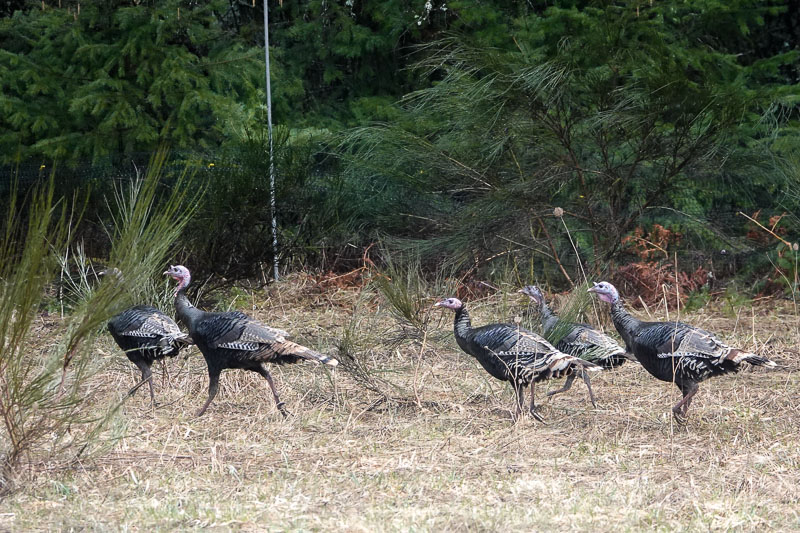 an elderly couple out for a walk, we found the road out to Strawberry Island L+ and there we found two more new species - Western Bluebird
and the elusive Rock Pigeon. In Stevenson we made two stops, to pick up our folding ramp and to get
coffee and breakfast pastries at Bigfoot Coffee Roasters. I find their Breakfast Ham Hand Pie very
tasty and their Marionberry Scone is also delicious. I wish I could comment on the coffee but I
can't remember it.
an elderly couple out for a walk, we found the road out to Strawberry Island L+ and there we found two more new species - Western Bluebird
and the elusive Rock Pigeon. In Stevenson we made two stops, to pick up our folding ramp and to get
coffee and breakfast pastries at Bigfoot Coffee Roasters. I find their Breakfast Ham Hand Pie very
tasty and their Marionberry Scone is also delicious. I wish I could comment on the coffee but I
can't remember it.
Darchelle having read a report of Wild Turkeys along Cook-Underwood Road, we followed it up out of the gorge and scanned field edges until we ran into a heavy graupel squall in the little town of Mill A. "Where do turkeys go in a storm", Darchelle wondered, "under a tree?" We found the turkeys, but not an answer to Darchelle's question, a mile out of town in a sunny pasture.

Wild Turkeys, Mill A, Skamania County
Darchelle having read a report of Wild Turkeys along Cook-Underwood Road, we followed it up out of the gorge and scanned field edges until we ran into a heavy graupel squall in the little town of Mill A. "Where do turkeys go in a storm", Darchelle wondered, "under a tree?" We found the turkeys, but not an answer to Darchelle's question, a mile out of town in a sunny pasture.
Klickitat County
The Wild Turkeys put me securely over 100 in Skamania County so we decided to dedicate the rest of
the afternoon to pursuing birds for Darchelle in nearby
Klickitat County m+. The east half of the county is mostly arid grassland but in the west half
Douglas Fir forest yields to diverse mixtures of Ponderosa Pine, Garry Oak, chaparral and grassland
in a dramatic landscape of basalt plateaus and deep canyons. Its shoreline of about 90 miles on the
Columbia River is the third longest of any county in the state. It has birds to pursue, 312 species on
the Washington Birder County
checklist + and in eBird +,
299 species on 22K checklists. Darchelle and I have been visiting Klickitat County since 2016 and
as of this morning, she had accumulated 88 species. This afternoon we found 13 more.Anticipating that we will be returning this summer, our focus today was on the Columbia River waterfront because most of the ducks will soon be headed north, and because it was raining and ducks don't mind rain. Bingen Pond L+ and Bingen Harbor L+ together gave us 9 new species, of which I missed a couple because the priority was getting birds for Darchelle.

Peregrine Falcon over Locke Lake

Common Raven in Garry Oak, Lyle

Turkey Vultures awaiting a storm, Lyle
It turned out that we did know the location L+, a pullout (a "layby" Barney called it) on the west side of the river just across the WA14 bridge from the town of Lyle. I spent a pleasant 10 minutes visiting with him while a sunbreak between rain showers filled the air with Turkey Vultures and Red-tails. He showed me a photo he had taken that morning of his first-of-year Barn Swallow; from its white underparts I identified it as the Asian subspecies after first misidentifying it as an Accipiter. I'm not sure where that left my credibility but that didn't really matter. I had nothing to prove.
A squall moved as we were moving out, lashing the 30 or so Turkey Vultures huddled in a Cottonwood along the road with wind-driven rain. I guess they're used to it.
4/02/2023 Cowlitz completed (link to here)
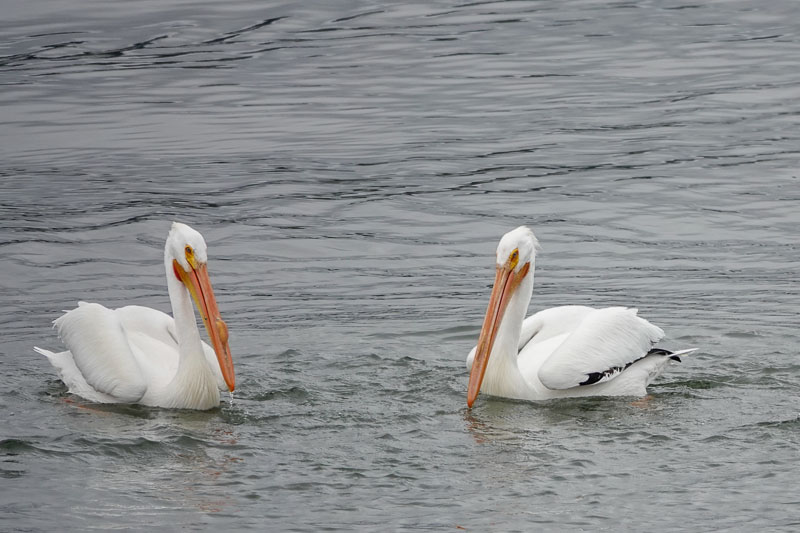
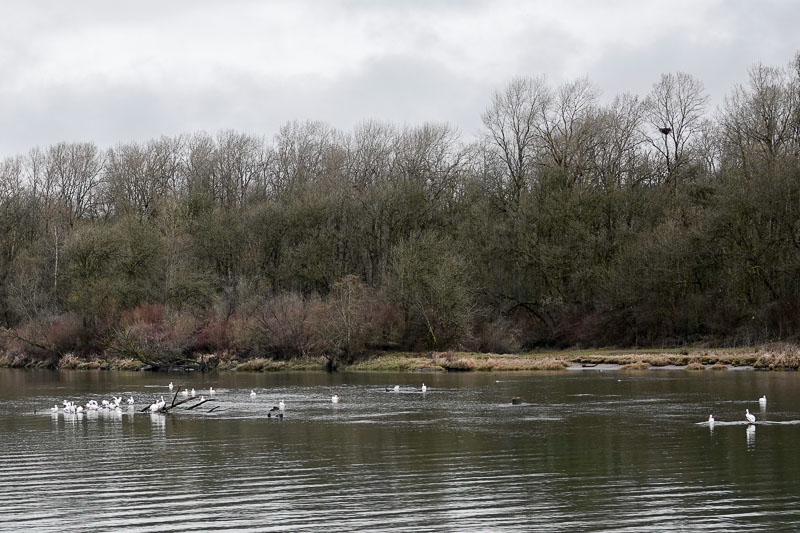
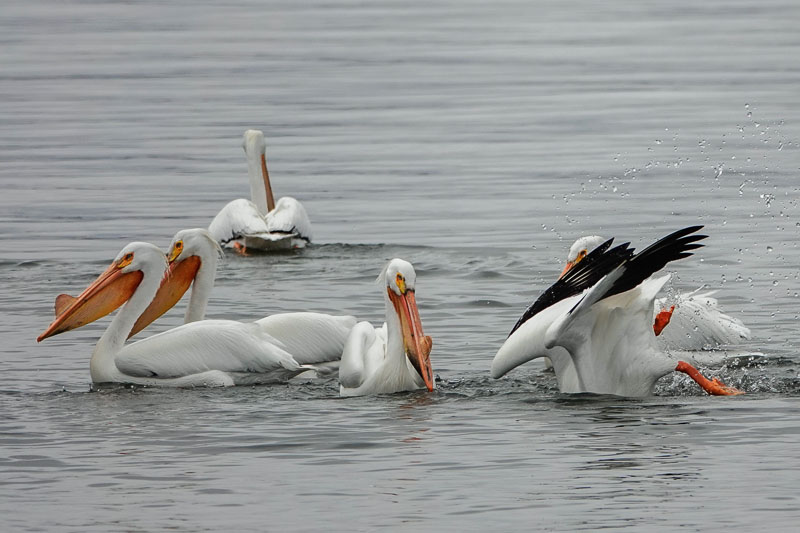 Today we visited sites along the Columbia River in
Cowlitz County from Woodland Bottoms to Kalama,
completing our brief survey of county hotspots and completing Darchelle's 100 species there. I
Today we visited sites along the Columbia River in
Cowlitz County from Woodland Bottoms to Kalama,
completing our brief survey of county hotspots and completing Darchelle's 100 species there. I
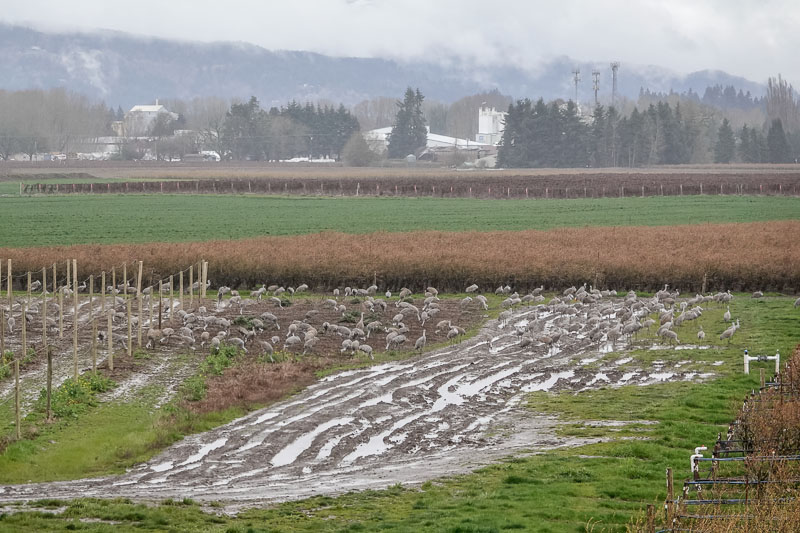 finished the day with 109 species and Darchelle with 102; her achievement is the more impressive
given that three days ago she had only 42 species in the county.
finished the day with 109 species and Darchelle with 102; her achievement is the more impressive
given that three days ago she had only 42 species in the county.
We said goodbye to Richard and Donna around 10:30AM just as a new round of rain moved in. Heading north we considered stopping in Ridgefield either for the refuge or for the food court but decided to prioritize Cowlitz instead, a good decision. In Woodland we took the Dike Access Road out to the dike, turned south and stopped in several spots along the Dike Road, sometimes on the road and sometimes down pothole-riddled tracks to the sandy water's edge, picking up a dozen new species for Darchelle including little birds in the cottonwoods and ducks and gulls out on the water L+. Most spectacular were the American White Pelicans, over 100 of them loitering at the mouth of the Lewis River L+ luring photographers like us out to impede local traffic on the dike.
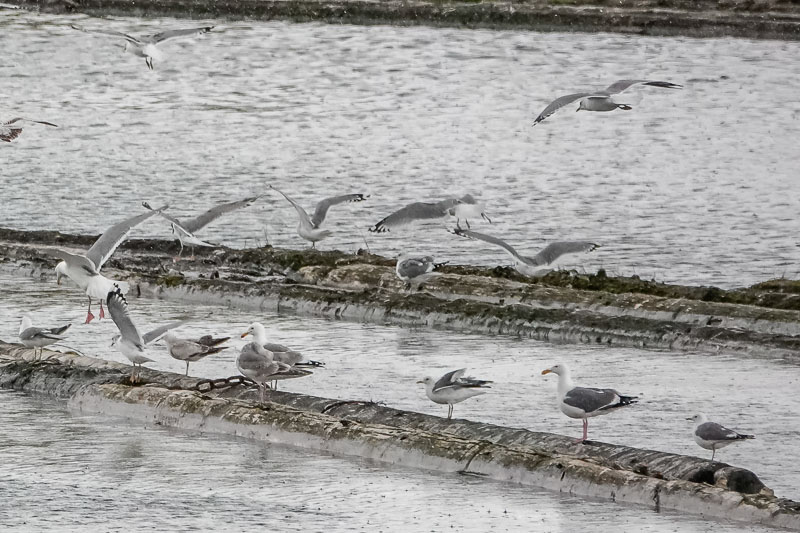
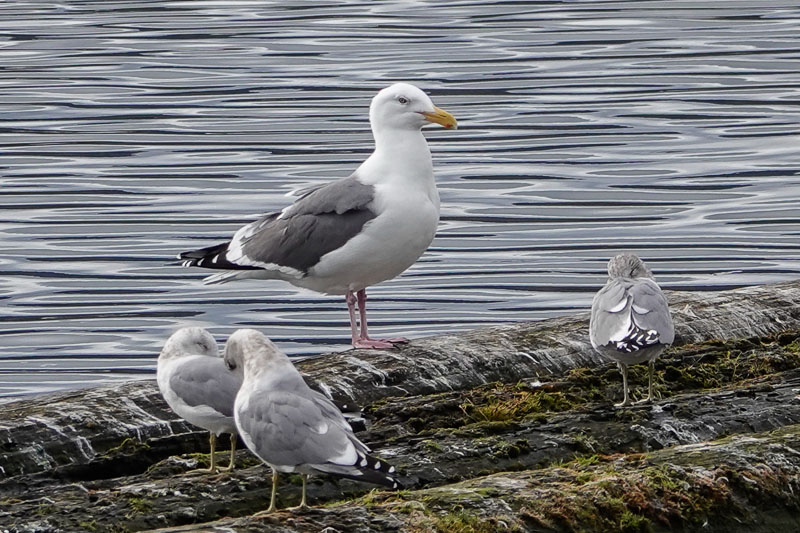
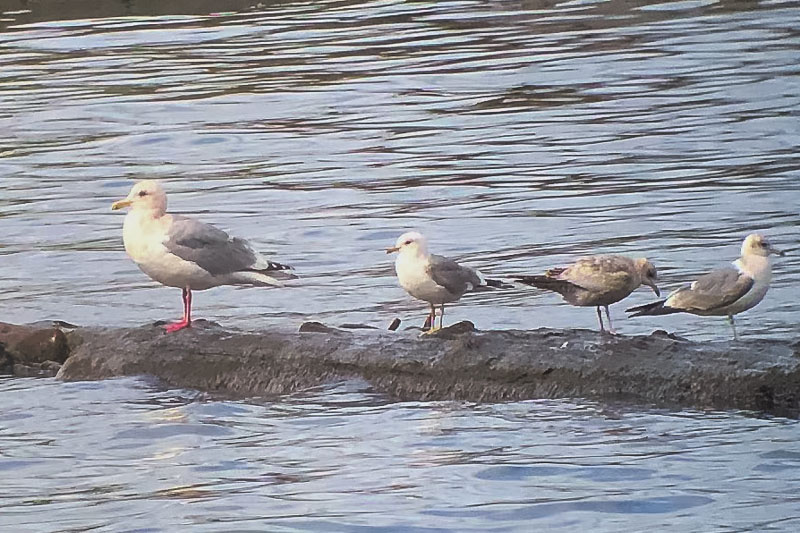
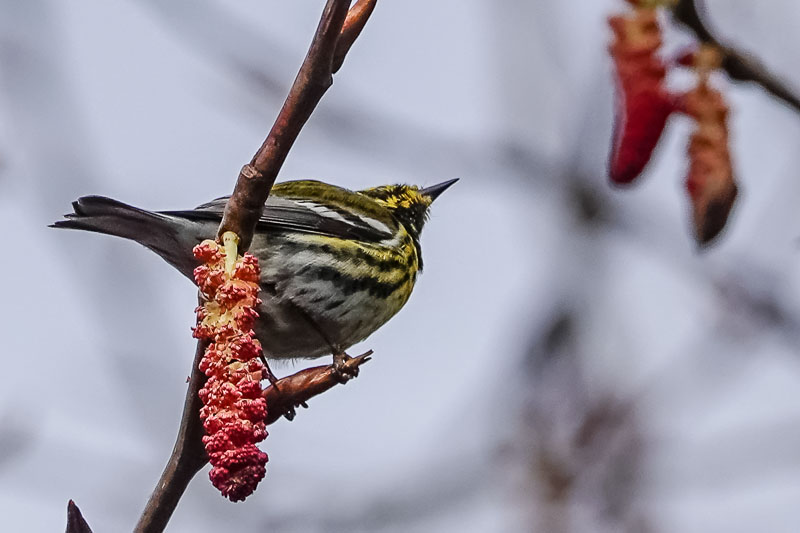 Having heard that gulls hang out at the Kalama Marina L+ we stopped there next and drove as far as we could through the
parking lot before we discovered the log booms where the gulls roost. There we eventually picked
out seven different species. I thought I heard an eighth, a Caspian Tern, but the calls I thought I
heard turned out to be the windshield wipers rubbing on the dry windshield. The rain had
stopped.
Having heard that gulls hang out at the Kalama Marina L+ we stopped there next and drove as far as we could through the
parking lot before we discovered the log booms where the gulls roost. There we eventually picked
out seven different species. I thought I heard an eighth, a Caspian Tern, but the calls I thought I
heard turned out to be the windshield wipers rubbing on the dry windshield. The rain had
stopped.
Our final planned stop of the day, the Kalama River mouth, was a bust but just across the river we stumbled upon a delightful spot - Sportsmen's Club Road L+, where a grove of tall cottonwoods overlooks a sandbar just offshore in the river. Anticipating that we might find a Brown Creeper there, we called in a flock of small birds which included a flashy male Townsend's Warbler along with chickadees and two Brown Creepers.

American White Pelicans, Woodland

American White Pelicans, Woodland

American White Pelicans, Woodland

Sandhill Cranes, Woodland Bottoms
We said goodbye to Richard and Donna around 10:30AM just as a new round of rain moved in. Heading north we considered stopping in Ridgefield either for the refuge or for the food court but decided to prioritize Cowlitz instead, a good decision. In Woodland we took the Dike Access Road out to the dike, turned south and stopped in several spots along the Dike Road, sometimes on the road and sometimes down pothole-riddled tracks to the sandy water's edge, picking up a dozen new species for Darchelle including little birds in the cottonwoods and ducks and gulls out on the water L+. Most spectacular were the American White Pelicans, over 100 of them loitering at the mouth of the Lewis River L+ luring photographers like us out to impede local traffic on the dike.

Glaucous-winged, California, Western and Short-billed Gulls, Kalama

Western and Short-billed Gulls, Kalama Marina

Iceland and Short-billed Gulls, Kalama Marina

Townsend's Warbler, Kalama
Our final planned stop of the day, the Kalama River mouth, was a bust but just across the river we stumbled upon a delightful spot - Sportsmen's Club Road L+, where a grove of tall cottonwoods overlooks a sandbar just offshore in the river. Anticipating that we might find a Brown Creeper there, we called in a flock of small birds which included a flashy male Townsend's Warbler along with chickadees and two Brown Creepers.
4/06/2023 Woodpeckers with Liam (link to here)
Liam was on break from school this week and we were heading over to the east side to look for a few sagebrush species. He was (is?) still considering a statewide big year this year for which he needed several birds in the southeast corner of the state and we are trying to get our Franklin County totals up to 100 so we made plans to spend a night in Walla Walla after picking up our Yakima Training Center permits. The training center is the best place I know to get sagebrush species but in order to get on the base early in the morning, you have to get your permits in advance. And so we did, this afternoon.
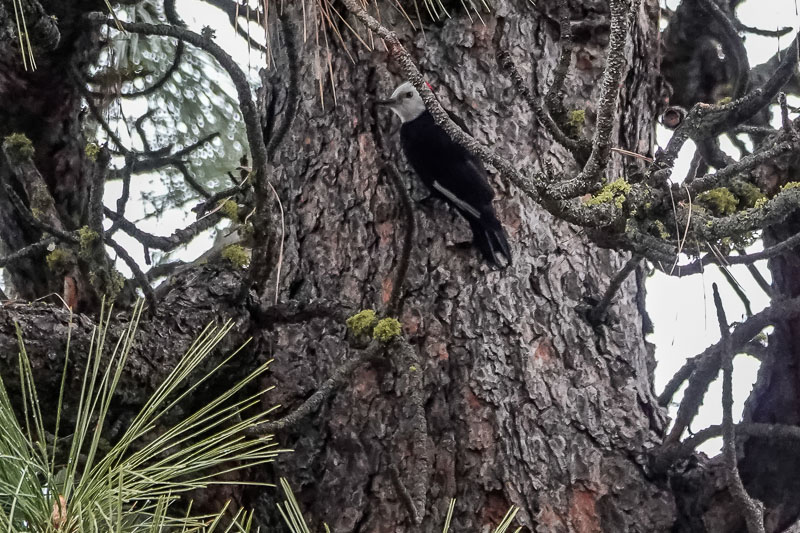
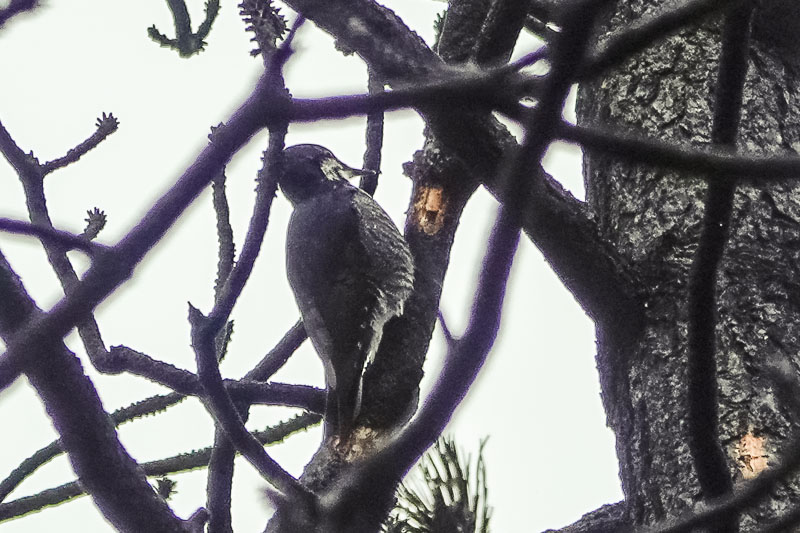
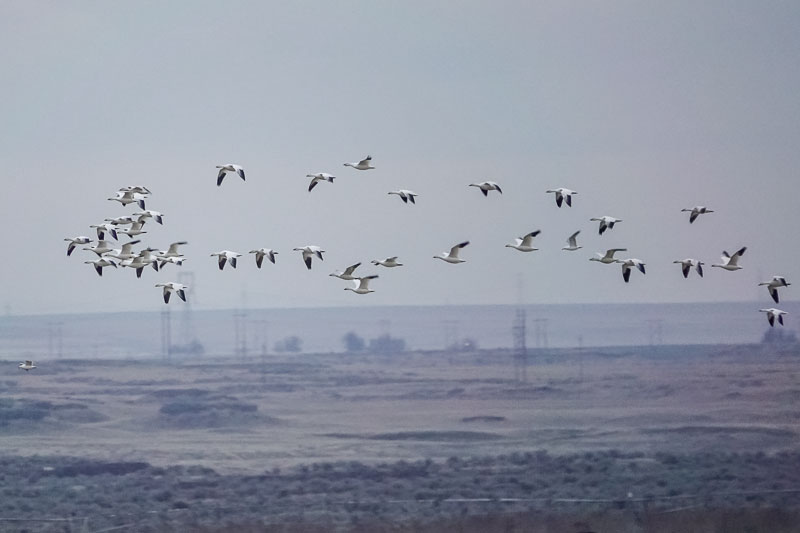 But first we wanted to try for a few species, particularly White-headed Woodpecker and Red-naped
Sapsucker, in the pine forests of the Cascade foothills. The morning was cloudy and damp on both
sides of the mountains. Sagging snowbanks glowered at us from both sides of the freeway as we
crossed the pass, the few inches of fresh new snow sitting on top of the dirty layers of old snow
like a party hat on a pig. The ground was bare and greening up a bit in Cle Elum where we stopped
at White Road L+ and
Hart Road L+ to search in vain
the White-headed Woodpeckers which we have found there in prior years.
But first we wanted to try for a few species, particularly White-headed Woodpecker and Red-naped
Sapsucker, in the pine forests of the Cascade foothills. The morning was cloudy and damp on both
sides of the mountains. Sagging snowbanks glowered at us from both sides of the freeway as we
crossed the pass, the few inches of fresh new snow sitting on top of the dirty layers of old snow
like a party hat on a pig. The ground was bare and greening up a bit in Cle Elum where we stopped
at White Road L+ and
Hart Road L+ to search in vain
the White-headed Woodpeckers which we have found there in prior years.
We have found White-headed Woodpeckers on North Wenas Road L+ in the past as well, particularly in the mile or so east of the height of land at Ellensburg Pass. I did not realize that area had burned last summer. Many of the pines were killed and salvage logging was underway; our prospects for finding a woodpecker with a clean white head looked dim but we stopped there m+ and played a few calls anyhow. Woodpeckers responded with drumming, several of them, and Liam noticed that some of the drumming sounded not like a Northern Flicker (long, very fast steady pace) or like Hairy (moderate length, very fast steady pace), Downy (fairly short, fairly slow steady pace) or White-headed (moderate length, moderate steady pace), but like a Three-toed (moderate length, moderate pace slowing and fading at the end). Three-toed Woodpeckers rarely frequent Ponderosa Pines, even burned ones, but Black-backs do. Their drumming is similar to a Three-toed but longer, and that fit what we were hearing, but they are hard to find and we did not expect to come across one today, let alone a virtual flock of them.
Two White-headed Woodpeckers flew in first, then a Black-backed, and while we watched that one, we heard another behind us and then a third one off to our right. When we stopped again about a half mile up the road we heard another (along with a distant and faint Sooty Grouse which I could not hear), and then on the other side of the pass, two more woodpeckers and another Sooty Grouse which I also could not hear. It was frustrating not to be able to hear the grouse but at least I heard and
Liam was on break from school this week and we were heading over to the east side to look for a few sagebrush species. He was (is?) still considering a statewide big year this year for which he needed several birds in the southeast corner of the state and we are trying to get our Franklin County totals up to 100 so we made plans to spend a night in Walla Walla after picking up our Yakima Training Center permits. The training center is the best place I know to get sagebrush species but in order to get on the base early in the morning, you have to get your permits in advance. And so we did, this afternoon.

White-headed Woodpecker, North Wenas Road

Black-backed Woodpecker, North Wenas Road

Snow Geese, Scooteney Reservoir
We have found White-headed Woodpeckers on North Wenas Road L+ in the past as well, particularly in the mile or so east of the height of land at Ellensburg Pass. I did not realize that area had burned last summer. Many of the pines were killed and salvage logging was underway; our prospects for finding a woodpecker with a clean white head looked dim but we stopped there m+ and played a few calls anyhow. Woodpeckers responded with drumming, several of them, and Liam noticed that some of the drumming sounded not like a Northern Flicker (long, very fast steady pace) or like Hairy (moderate length, very fast steady pace), Downy (fairly short, fairly slow steady pace) or White-headed (moderate length, moderate steady pace), but like a Three-toed (moderate length, moderate pace slowing and fading at the end). Three-toed Woodpeckers rarely frequent Ponderosa Pines, even burned ones, but Black-backs do. Their drumming is similar to a Three-toed but longer, and that fit what we were hearing, but they are hard to find and we did not expect to come across one today, let alone a virtual flock of them.
Two White-headed Woodpeckers flew in first, then a Black-backed, and while we watched that one, we heard another behind us and then a third one off to our right. When we stopped again about a half mile up the road we heard another (along with a distant and faint Sooty Grouse which I could not hear), and then on the other side of the pass, two more woodpeckers and another Sooty Grouse which I also could not hear. It was frustrating not to be able to hear the grouse but at least I heard and
saw both species of woodpeckers.
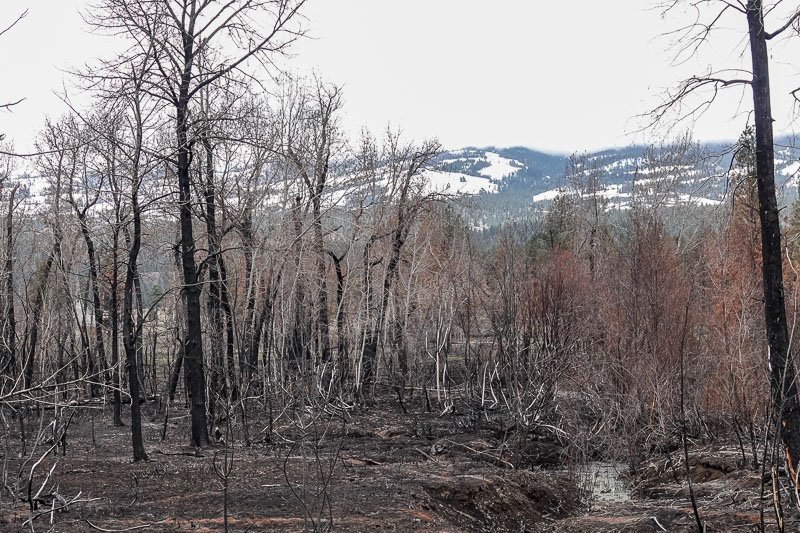
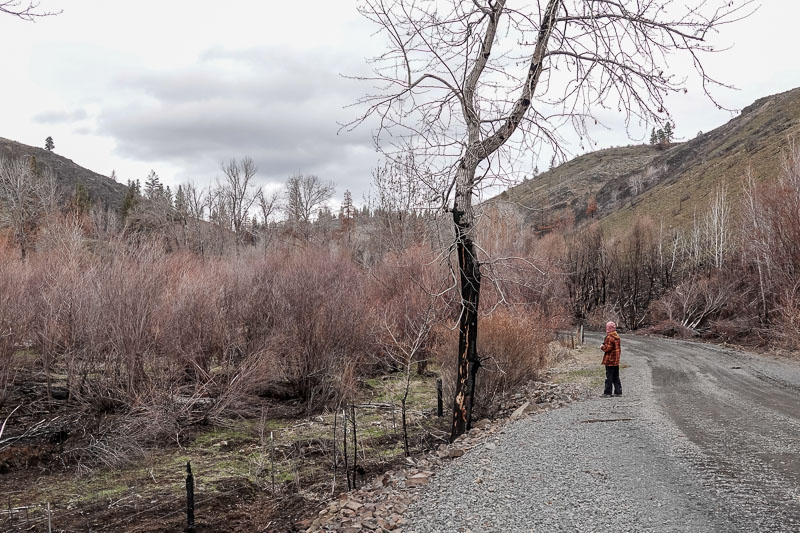
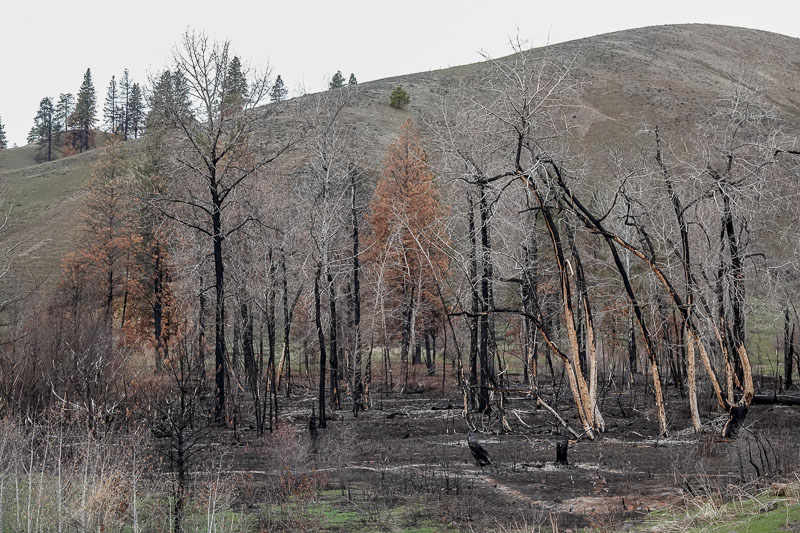 Down on Maloy Road L+ none of
us heard or saw the Red-naped Sapsucker which should have been there by then, nor could we find a
Ruffed Grouse for Liam. The riparian habitat along Wenas Creek at Maloy Road has not burned, yet,
though the same fire which killed the pines on North Wenas Road scoured the valley a mile upstream
and another big fire a few years ago destroyed the riparian woodlands most of the way down to Wenas
Lake. The trees and shrubs along the stream will grow back of course, but given the increasing
frequency of severe fires, the mature riparian forest may not return within any of our lifetimes.
The same is true of the expanses of sagebrush across so much of eastern Washington; once the sage
has burned, the highly flammable weeds which replace it will burn too frequently for the sagebrush
to become reestablished. The charred landscape develops a beautiful green carpet in April but by
the end of May is pale and parched, ready to burn again and hospitable to neither birds nor mammals.
I won't miss the original richness of flora and fauna after I'm gone but I hate to see it destroyed
nonetheless.
Down on Maloy Road L+ none of
us heard or saw the Red-naped Sapsucker which should have been there by then, nor could we find a
Ruffed Grouse for Liam. The riparian habitat along Wenas Creek at Maloy Road has not burned, yet,
though the same fire which killed the pines on North Wenas Road scoured the valley a mile upstream
and another big fire a few years ago destroyed the riparian woodlands most of the way down to Wenas
Lake. The trees and shrubs along the stream will grow back of course, but given the increasing
frequency of severe fires, the mature riparian forest may not return within any of our lifetimes.
The same is true of the expanses of sagebrush across so much of eastern Washington; once the sage
has burned, the highly flammable weeds which replace it will burn too frequently for the sagebrush
to become reestablished. The charred landscape develops a beautiful green carpet in April but by
the end of May is pale and parched, ready to burn again and hospitable to neither birds nor mammals.
I won't miss the original richness of flora and fauna after I'm gone but I hate to see it destroyed
nonetheless.
With Liam being underage we had anticipated difficulty acquiring a permit for him but Elizabeth assembled a packet of documents which proved sufficient. Had we taking a few minutes to test our access to the base using our new permits, we might have saved ourselves an hour's delay early Saturday morning but we were eager to be on our way east and south so we did not. Instead we drove out the Black Rock Valley to Hwy 241 then south 2.5 miles to our Long-billed Curlew spot. Liam, who already has it for the year, heard one; Darchelle and I, who do not, did not. Continuing towards Othello we all spotted our first Cliff Swallows of the year at Vernita Bridge and at the grain elevators on the north edge of town, our first Tri-colored Blackbird.
Scooteney Reservoir L+ looked like our best option for picking up new species in Franklin County so we stopped there on our way south to Tri-Cities, which we thought we might reach in time to see the Burrowing Owl at the airport. We might have too, had we not devoted the last hour of daylight to a search for the Snow Goose flock in which Liam thought he might have seen a rare Ross's Goose. We found the Snow Greese though not the Ross's but at least the effort rewarded us with almost a dozen new species for the county.

Burned riparian habitat along Wenas Creek

Liam on Wenas Creek road

Burned riparian habitat along Wenas Creek
With Liam being underage we had anticipated difficulty acquiring a permit for him but Elizabeth assembled a packet of documents which proved sufficient. Had we taking a few minutes to test our access to the base using our new permits, we might have saved ourselves an hour's delay early Saturday morning but we were eager to be on our way east and south so we did not. Instead we drove out the Black Rock Valley to Hwy 241 then south 2.5 miles to our Long-billed Curlew spot. Liam, who already has it for the year, heard one; Darchelle and I, who do not, did not. Continuing towards Othello we all spotted our first Cliff Swallows of the year at Vernita Bridge and at the grain elevators on the north edge of town, our first Tri-colored Blackbird.
Scooteney Reservoir L+ looked like our best option for picking up new species in Franklin County so we stopped there on our way south to Tri-Cities, which we thought we might reach in time to see the Burrowing Owl at the airport. We might have too, had we not devoted the last hour of daylight to a search for the Snow Goose flock in which Liam thought he might have seen a rare Ross's Goose. We found the Snow Greese though not the Ross's but at least the effort rewarded us with almost a dozen new species for the county.
4/07/2023 Skunked in Tri-Cities with Liam (link to here)
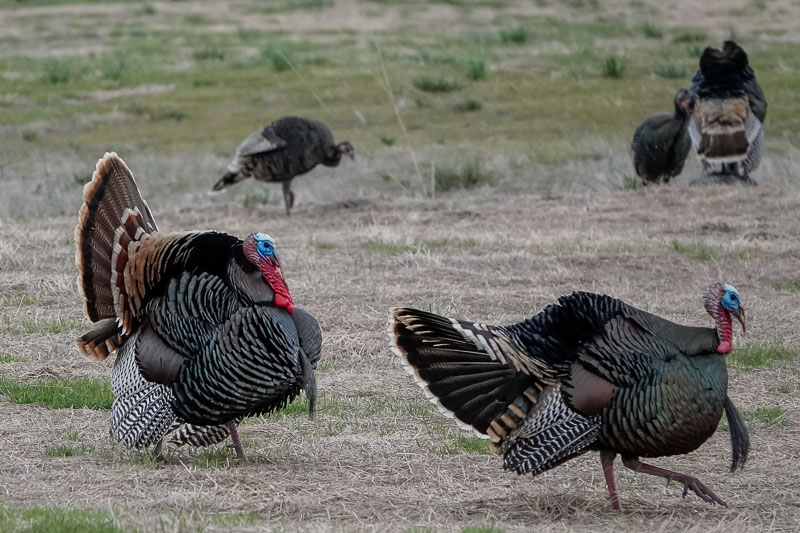
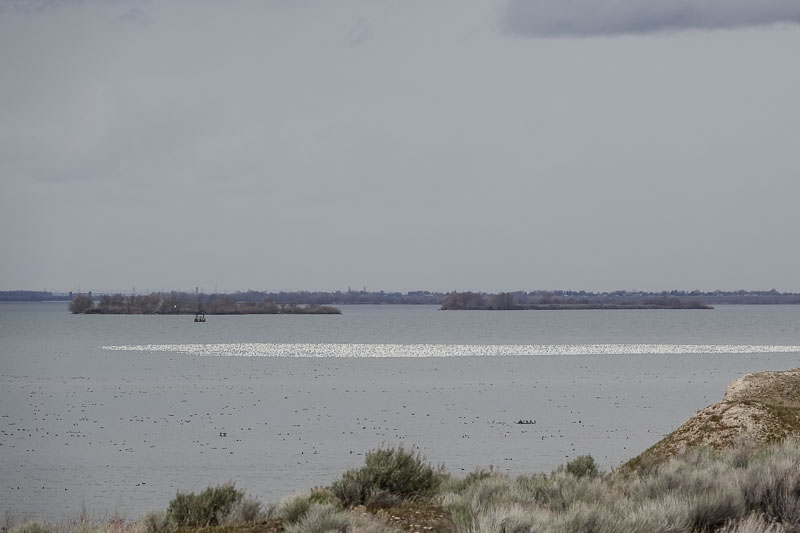
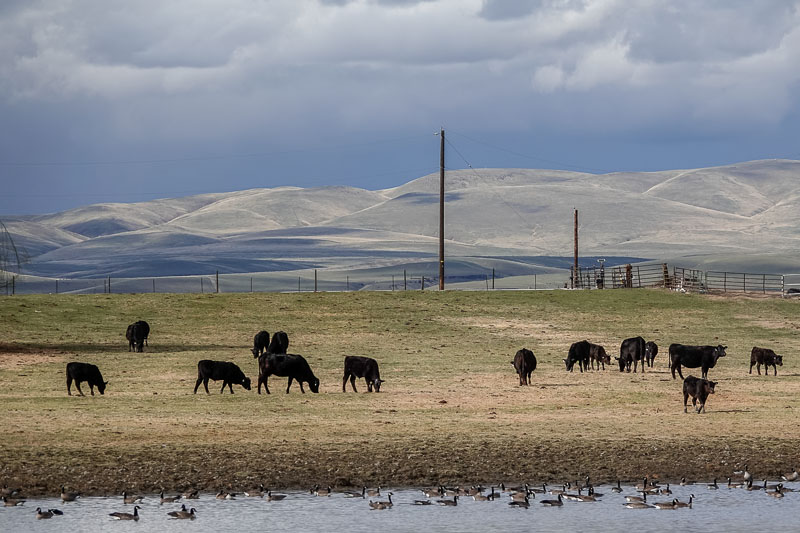 Chasing particular species today on our way from Walla Walla to Yakima, we had scant success until
we finally found a Black-necked Stilt at Kerry's Pond L+. We had also been able to show Liam the Ferruginous Hawk at
Nine Mile Canyon Rd L+ but we
had missed a Blue-winged Teal in College Place, a Swainson's Hawk in Touchet, a Black-crowned
Night-Heron in Richland, the Burrowing Owl in Pasco and Long-billed Curlews everywhere.
Chasing particular species today on our way from Walla Walla to Yakima, we had scant success until
we finally found a Black-necked Stilt at Kerry's Pond L+. We had also been able to show Liam the Ferruginous Hawk at
Nine Mile Canyon Rd L+ but we
had missed a Blue-winged Teal in College Place, a Swainson's Hawk in Touchet, a Black-crowned
Night-Heron in Richland, the Burrowing Owl in Pasco and Long-billed Curlews everywhere.
We spent the night with Andy and Ellen, who fixed us her delicious Spanakopita casserole for dinner while Andy and Liam swapped avian arcana at their end of the table.

Wild Turkeys displaying, Walla Walla

Snow Geese, Walla Walla River Delta

Black-necked Stilt (bottom left), Kerry's Pond
We spent the night with Andy and Ellen, who fixed us her delicious Spanakopita casserole for dinner while Andy and Liam swapped avian arcana at their end of the table.
4/08/2023 Shrub-Steppes with Liam (link to here)

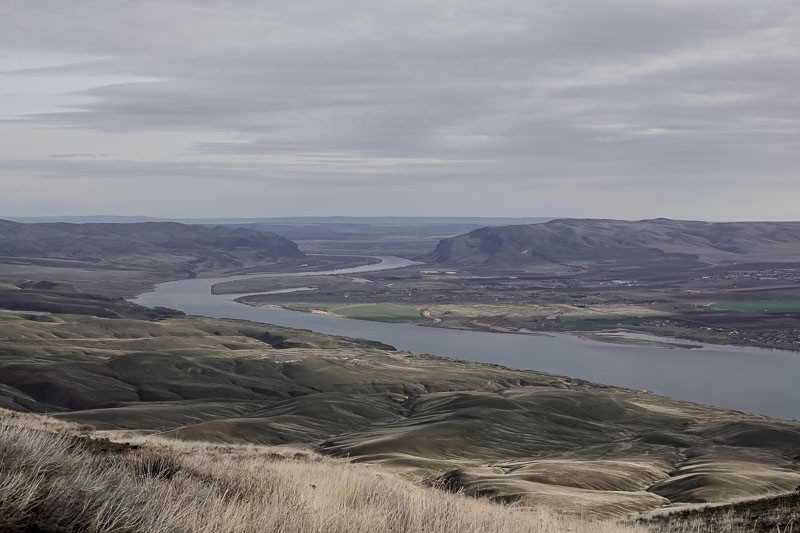
 On the Yakima Training Center L+
we found all of the sagebrush birds we had counted on but failed for the most part to get good
photos, hence the display of landscape shots above. Even I at least heard the one I couldn't see, a
Sage Thrasher. Headed for Area 6, we drove up over the
Selah/Cold Creek divide and down the other side to Filey Road, turned left and followed Filey Road
to the top of Umtanum Ridge where we were rewarded with a spectacular view north over the Columbia
River to Saddle Mt and beyond. Not many birds up there though the Selah Creek valley hosted lots of
Harriers.
On the Yakima Training Center L+
we found all of the sagebrush birds we had counted on but failed for the most part to get good
photos, hence the display of landscape shots above. Even I at least heard the one I couldn't see, a
Sage Thrasher. Headed for Area 6, we drove up over the
Selah/Cold Creek divide and down the other side to Filey Road, turned left and followed Filey Road
to the top of Umtanum Ridge where we were rewarded with a spectacular view north over the Columbia
River to Saddle Mt and beyond. Not many birds up there though the Selah Creek valley hosted lots of
Harriers.
We were an hour late getting on to the training center grounds because when we pulled up to the entrance station at 5:30 AM the guard informed us that we could not enter unless we each had a blaze orange hunting vest in our possession, if not on our person, and that it did not matter that we were not planning to exit our vehicle because we were not allowed to exit our vehicle. "So much for our sagebrush species today", I thought. "What are the chances of purchasing an orange vest at 6 AM on Saturday morning in Yakima?" Undaunted, we drove over to Walmart, parked in the big empty lot and waited for someone to show up. Shortly before 6 AM someone opened a side door and let Liam and Darchelle inside and 15 minutes later they emerged with three blaze orange hunting vests. Appropriately armed, we approached the guard station again, brandished our vests and were immediately admitted, or at least allowed to pick up our permits for the day. I think they were expecting us

Shrub-Steppe in the Selah Creek valley, Yakima Training Center

Saddle Mt from Umtanum Ridge (46.641135 -120.047431)

Shrub-Steppe in the Cold Creek valley, Yakima Training Center
We were an hour late getting on to the training center grounds because when we pulled up to the entrance station at 5:30 AM the guard informed us that we could not enter unless we each had a blaze orange hunting vest in our possession, if not on our person, and that it did not matter that we were not planning to exit our vehicle because we were not allowed to exit our vehicle. "So much for our sagebrush species today", I thought. "What are the chances of purchasing an orange vest at 6 AM on Saturday morning in Yakima?" Undaunted, we drove over to Walmart, parked in the big empty lot and waited for someone to show up. Shortly before 6 AM someone opened a side door and let Liam and Darchelle inside and 15 minutes later they emerged with three blaze orange hunting vests. Appropriately armed, we approached the guard station again, brandished our vests and were immediately admitted, or at least allowed to pick up our permits for the day. I think they were expecting us
because within a few more minutes we were on our way, heading east into the sunrise.
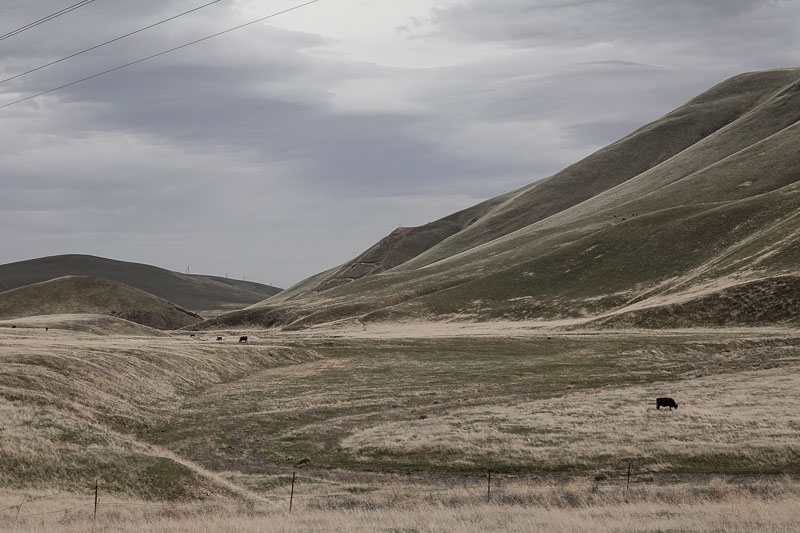
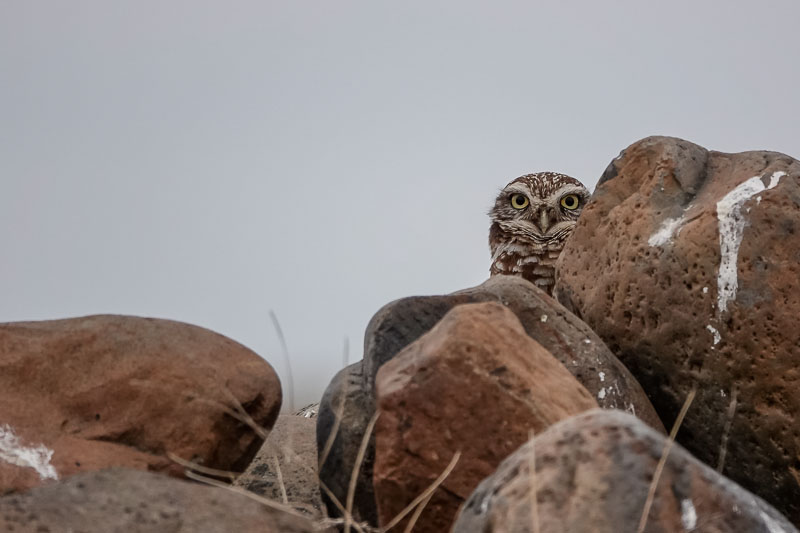
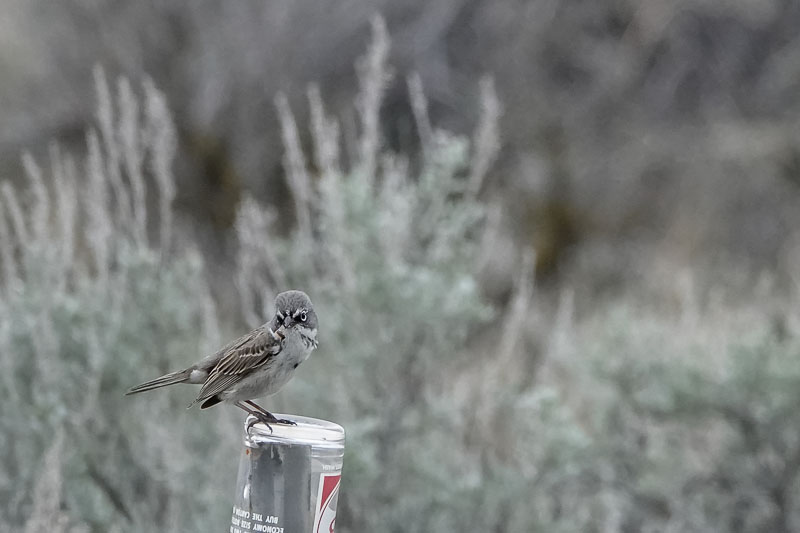 After failing to find either White-throated Swifts or Lewis's Woodpeckers east of Natchez on Hwy 12,
we drove back through town and out the Black Rock Valley. Hops plantations have replaced
weedy grasslands in the valley east from Moxee in the 10 years since I first searched for Ferruginous
and Swainson's Hawks L+
and a Burrowing Owl L+ out there.
Today we saw a couple of Red-tails and not much else, though I was grateful to notice one or two
colonies of Antelope Ground Squirrels persisting in pastures along the way. At our
customary curlew location L+
along Hwy 241 a couple miles south of Hwy 24, we all heard the customary curlews which we (Darchelle
and I) had failed to find two days earlier.
After failing to find either White-throated Swifts or Lewis's Woodpeckers east of Natchez on Hwy 12,
we drove back through town and out the Black Rock Valley. Hops plantations have replaced
weedy grasslands in the valley east from Moxee in the 10 years since I first searched for Ferruginous
and Swainson's Hawks L+
and a Burrowing Owl L+ out there.
Today we saw a couple of Red-tails and not much else, though I was grateful to notice one or two
colonies of Antelope Ground Squirrels persisting in pastures along the way. At our
customary curlew location L+
along Hwy 241 a couple miles south of Hwy 24, we all heard the customary curlews which we (Darchelle
and I) had failed to find two days earlier.
We devoted the rest of the afternoon to efforts to add a Burrowing Owl to Liam's year list and a Sagebrush Sparrow to his photo list. Along the way we drove out Lower Crab Creek Road L+ hoping for the Sagebrush Sparrow as well as an early Avocet. Why I persist in searching for the latter species along Lower Crab Creek Road I don't know, since I have no record of seeing any there in the past 10 years, but I nonetheless always enjoy trying to puzzle out the Quaternary geology + of the north slope of the Saddle Mountains along that route. Faulting, flooding and mass wasting all play a role but I've never been able to decide what did what. Anyhow, we found the owl as advertised near Ephrata L+ and down on the floor of Frenchman Coulee L+, a very cooperative Sagebrush Sparrow. More colorful by far than the sparrow were the camps of hundreds of climbers along the road down into the coulee. Being in a bit of a hurry to get back to Yakima for dinner with Andy and Ellen again, we did not stop for photos.

Black Rock Valley (46.534966, -119.914298)

Burrowing Owl, Ephrata

Sagebrush Sparrow, Frenchman Coulee
We devoted the rest of the afternoon to efforts to add a Burrowing Owl to Liam's year list and a Sagebrush Sparrow to his photo list. Along the way we drove out Lower Crab Creek Road L+ hoping for the Sagebrush Sparrow as well as an early Avocet. Why I persist in searching for the latter species along Lower Crab Creek Road I don't know, since I have no record of seeing any there in the past 10 years, but I nonetheless always enjoy trying to puzzle out the Quaternary geology + of the north slope of the Saddle Mountains along that route. Faulting, flooding and mass wasting all play a role but I've never been able to decide what did what. Anyhow, we found the owl as advertised near Ephrata L+ and down on the floor of Frenchman Coulee L+, a very cooperative Sagebrush Sparrow. More colorful by far than the sparrow were the camps of hundreds of climbers along the road down into the coulee. Being in a bit of a hurry to get back to Yakima for dinner with Andy and Ellen again, we did not stop for photos.
4/09/2023 East-slope Efforts with Liam and Andy (link to here)
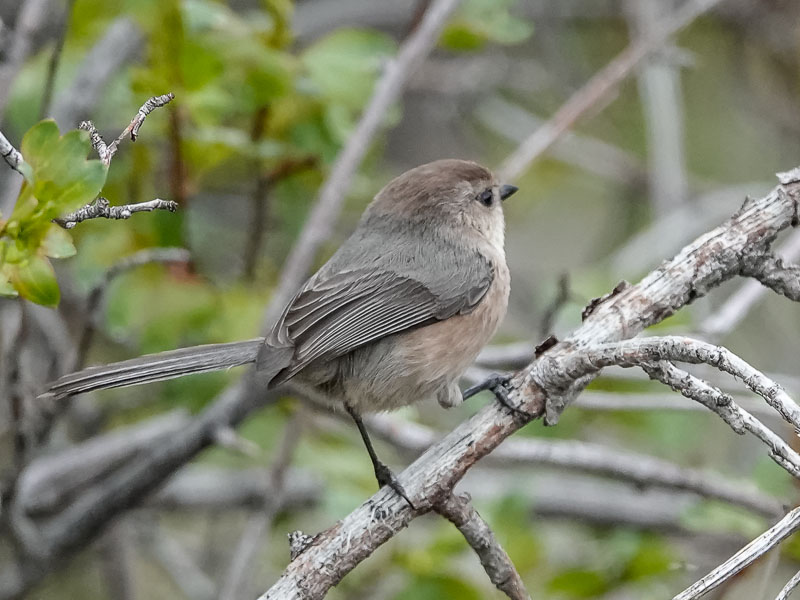

 After failing again to find either White-throated Swifts or Lewis's Woodpeckers east of Natchez on
Hwy 12, we drove up the Wenas Valley and determined again that Red-naped Sapsuckers have not yet
arrived. Andy continued with us up to Ellensburg Pass and succeeded in spotting the Black-backed
Woodpeckers he had tentatively heard there a few days earlier. While he and Liam were searching for
woodpeckers Darchelle and I lingered just east of the pass listening for Sooty Grouse. Eventually
I heard one call twice but Darchelle, who was listening about 50 yards down the road, did not hear
it so I still wonder if maybe what I heard was a phantom. If so, it was a remarkably clear phantom.
After failing again to find either White-throated Swifts or Lewis's Woodpeckers east of Natchez on
Hwy 12, we drove up the Wenas Valley and determined again that Red-naped Sapsuckers have not yet
arrived. Andy continued with us up to Ellensburg Pass and succeeded in spotting the Black-backed
Woodpeckers he had tentatively heard there a few days earlier. While he and Liam were searching for
woodpeckers Darchelle and I lingered just east of the pass listening for Sooty Grouse. Eventually
I heard one call twice but Darchelle, who was listening about 50 yards down the road, did not hear
it so I still wonder if maybe what I heard was a phantom. If so, it was a remarkably clear phantom.
On our way home we detoured up to Liberty and drove three miles up FR 9712 L+ on rain-soaked ice to look for our first of the year Williamson's Sapsuckers. We found them. For us they were the 16th new year bird of the trip, making it difficult despite our numerous misses to argue that the trip was a failure. Liam added a few more birds than we did because his last trip to southeastern Washington was back in January. He certainly helped us find more birds than we might have otherwise but I think for him, the opportunity to hang out with Andy was probably the real highlight of the trip.

Bushtit (Pacific race), Naches

Searching for Williamson's Sapsuckers near Liberty

Our scorecard for the trip
On our way home we detoured up to Liberty and drove three miles up FR 9712 L+ on rain-soaked ice to look for our first of the year Williamson's Sapsuckers. We found them. For us they were the 16th new year bird of the trip, making it difficult despite our numerous misses to argue that the trip was a failure. Liam added a few more birds than we did because his last trip to southeastern Washington was back in January. He certainly helped us find more birds than we might have otherwise but I think for him, the opportunity to hang out with Andy was probably the real highlight of the trip.
4/10/2023 Black-headed Gull #232 (link to here)
More rain this morning. According to the proverb intermittent precipitation is expected this time of year but I'm tired of the overcast and rain nonetheless. We were both tired from our trip to Eastern Washington as well. We went to bed before 11 and did not get up until after 10. In the morning the swelling in my feet had sufficiently subsided that I had ankles again.
We had lingered in the kitchen over our late coffee and breakfast until well after noon so I had only been on the computer for an hour or two when Darchelle announced that the Black-headed Gull was currently loafing off Redondo Beach. Raphael was watching it through his scope at that very moment. When the gull, which is probably the same bird we saw nearby during the first week of April last year, was first discovered yesterday afternoon Darchelle and I resolved that we would not chase it unless we had a pretty good chance of seeing it. This afternoon after a few minutes of deliberation, we loaded ourselves into the car and tackled an hour of southbound traffic in the rain to chase the gull. So much for resolve. After my experience last year I did not expect to see the gull but I was not getting much done on the computer so I figured I might as well go out for a ride.

 I did see the gull this time, thanks to Raphael's assistance. He was still there when we arrived,
standing under the pier L+
peering through his scope. At my suggestion Darchelle parked down on the concrete boat launch ramp
and walked over to Raphael to view the gull through his scope before setting up ours. I sat in the
car for about 20 minutes and watched them watching the bird, which was too far out on the water for
me to see. Darchelle brought the scope back to the car and both she and Raphael tried to position it
so I could see the bird through it. When that didn't work we suggested that Raphael put his phone up
to the eyepiece of the scope as if he were digiscoping so that I could see the image on his phone.
That worked and I got to watch the Black-headed Gull swimming back and forth with a Bonaparte's Gull
while Raphael captured it all on video. I felt inordinately grateful to him for his help.
I did see the gull this time, thanks to Raphael's assistance. He was still there when we arrived,
standing under the pier L+
peering through his scope. At my suggestion Darchelle parked down on the concrete boat launch ramp
and walked over to Raphael to view the gull through his scope before setting up ours. I sat in the
car for about 20 minutes and watched them watching the bird, which was too far out on the water for
me to see. Darchelle brought the scope back to the car and both she and Raphael tried to position it
so I could see the bird through it. When that didn't work we suggested that Raphael put his phone up
to the eyepiece of the scope as if he were digiscoping so that I could see the image on his phone.
That worked and I got to watch the Black-headed Gull swimming back and forth with a Bonaparte's Gull
while Raphael captured it all on video. I felt inordinately grateful to him for his help.
Darchelle, suspecting that Liam and Elizabeth would be on their way, texted that we were at Redondo Pier watching the bird but that it appeared to be heading towards Saltwater State Park so Raphael was on his way over there hoping for a better view. Liam wanted to join Raphael but Elizabeth insisted that they check in with us first since we were actually on the bird. That proved to be a good decision. They both saw the bird with us then we all drove over to Saltwater State Park L+ and searched in vain for it for another hour, proving the truth of the adage that "a bird that you see through someone else's scope is worth two that you fail to find on your own".
More rain this morning. According to the proverb intermittent precipitation is expected this time of year but I'm tired of the overcast and rain nonetheless. We were both tired from our trip to Eastern Washington as well. We went to bed before 11 and did not get up until after 10. In the morning the swelling in my feet had sufficiently subsided that I had ankles again.
We had lingered in the kitchen over our late coffee and breakfast until well after noon so I had only been on the computer for an hour or two when Darchelle announced that the Black-headed Gull was currently loafing off Redondo Beach. Raphael was watching it through his scope at that very moment. When the gull, which is probably the same bird we saw nearby during the first week of April last year, was first discovered yesterday afternoon Darchelle and I resolved that we would not chase it unless we had a pretty good chance of seeing it. This afternoon after a few minutes of deliberation, we loaded ourselves into the car and tackled an hour of southbound traffic in the rain to chase the gull. So much for resolve. After my experience last year I did not expect to see the gull but I was not getting much done on the computer so I figured I might as well go out for a ride.

Raphael showing me the Black-headed Gull

Black-headed and Bonaparte's Gull (photo by Raphael F)
Darchelle, suspecting that Liam and Elizabeth would be on their way, texted that we were at Redondo Pier watching the bird but that it appeared to be heading towards Saltwater State Park so Raphael was on his way over there hoping for a better view. Liam wanted to join Raphael but Elizabeth insisted that they check in with us first since we were actually on the bird. That proved to be a good decision. They both saw the bird with us then we all drove over to Saltwater State Park L+ and searched in vain for it for another hour, proving the truth of the adage that "a bird that you see through someone else's scope is worth two that you fail to find on your own".
4/13/2023 New Phones (link to here)
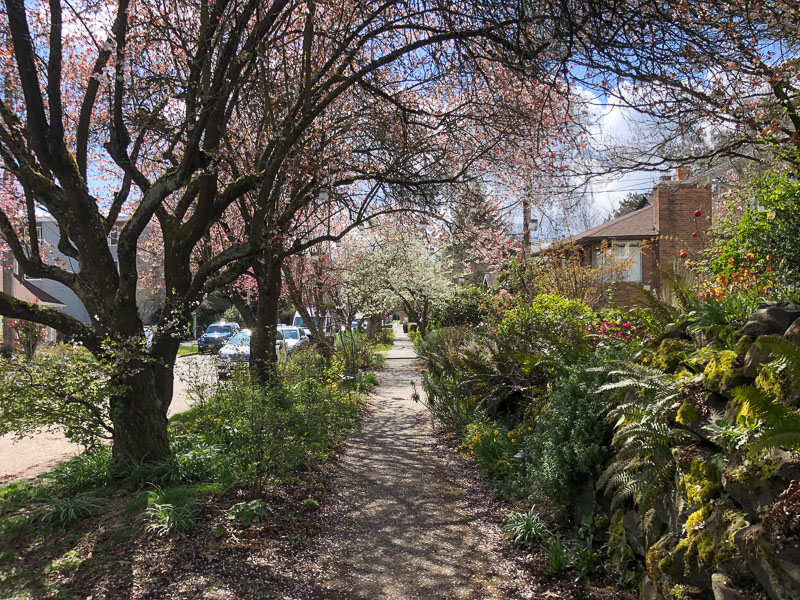

 Today was ALS clinic day. We drove over there after waking up late and foregoing coffee almost
entirely to meet with about half of the normal staff, it being school vacation week. Everyone with
children was out of the office and those who were left had little news to offer us. My breathing
has declined, I told them, but just the same I might like to reduce the inspiratory pressure for
daytime use to make talking easier. The new respiratory therapist wasn't familiar enough with the
Astral 150 to make that change, so we'll have to figure it out ourselves. My legs are getting weaker
so transfers are getting scarier but the only solution, a Hoyer lift, is not portable. Actually
there is another option, to get a van into which we could load the power chair, though at this point
I doubt I can control the power chair with my foot as originally planned. So no, not really any
solution that will allow us to continue getting out as we have been the past couple of years.
Today was ALS clinic day. We drove over there after waking up late and foregoing coffee almost
entirely to meet with about half of the normal staff, it being school vacation week. Everyone with
children was out of the office and those who were left had little news to offer us. My breathing
has declined, I told them, but just the same I might like to reduce the inspiratory pressure for
daytime use to make talking easier. The new respiratory therapist wasn't familiar enough with the
Astral 150 to make that change, so we'll have to figure it out ourselves. My legs are getting weaker
so transfers are getting scarier but the only solution, a Hoyer lift, is not portable. Actually
there is another option, to get a van into which we could load the power chair, though at this point
I doubt I can control the power chair with my foot as originally planned. So no, not really any
solution that will allow us to continue getting out as we have been the past couple of years.
Darchelle rewarded us with takeout from Plum Bistro - Mac 'n Yeast, a burger and a taco, all three delicious. We ate in the car then drove up to the Verizon store but Northgate to replace my dead Samsung S7. $830 later we walked out with two iPhone 14s. It was the prospect of being able to operate the iPhone with my voice which persuaded me to switch to Apple after all these years. Unfortunately my imperfect diction proved unequal to the task but I can at least originate a call by voice, even if I can't hang up.
Useful tips for using the iPhone:

Front sidewalk, 4 April

Kitchen and dining room, 13 April

Downstairs bathroom
Darchelle rewarded us with takeout from Plum Bistro - Mac 'n Yeast, a burger and a taco, all three delicious. We ate in the car then drove up to the Verizon store but Northgate to replace my dead Samsung S7. $830 later we walked out with two iPhone 14s. It was the prospect of being able to operate the iPhone with my voice which persuaded me to switch to Apple after all these years. Unfortunately my imperfect diction proved unequal to the task but I can at least originate a call by voice, even if I can't hang up.
Useful tips for using the iPhone:
Enable Google maps timeline on iPhone +
Voice command to unlock phone +
Prepare to return the old phone +
Based on this Internet speed test, our
Internet speed (via Ethernet connection) on the DSL network was about 840 Mbps for download and 890
Mbps for upload. The 5G network, at 300 Mbps for download and 20 Mbps for upload, is significantly
slower but perhaps still fast enough? The 5G network is also cheaper, $25 per month rather than
$65. Voice command to unlock phone +
Prepare to return the old phone +
4/21/2023 Whimbrels (link to here)
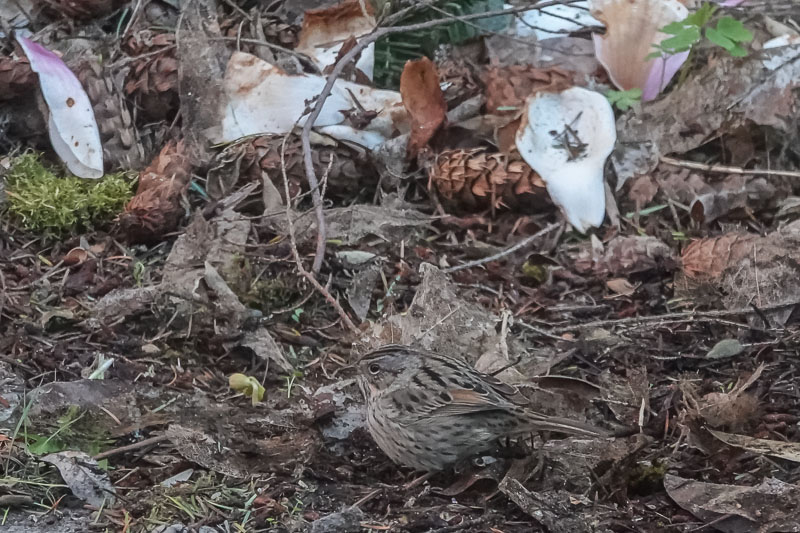
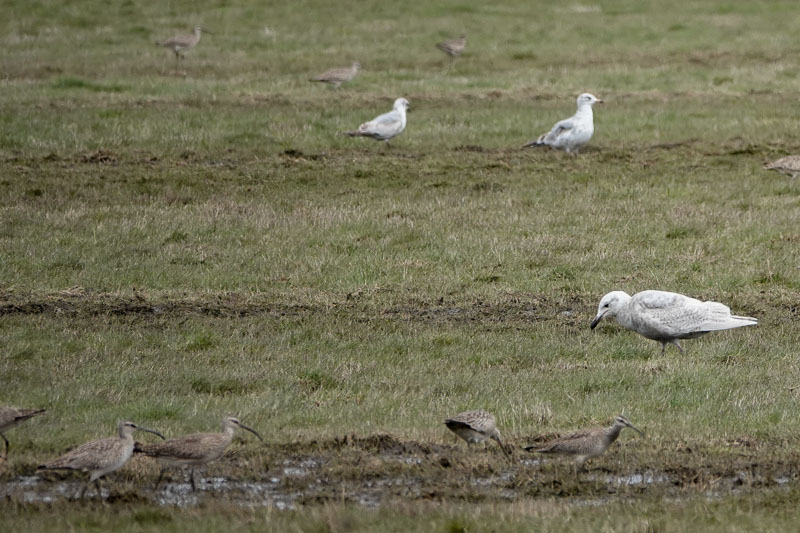
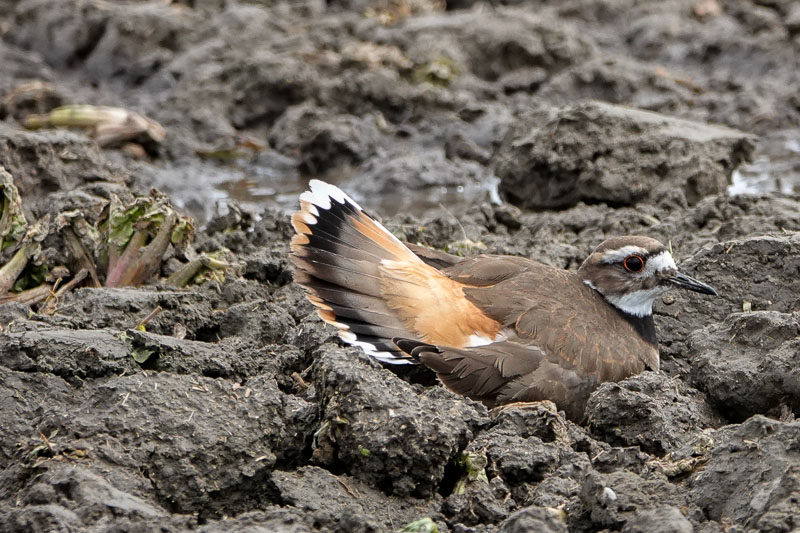 We may not be doing a big year in Washington state this year but we are also trying not to miss too
many species so when David P reported a good-sized flock
of Whimbrels in Arlington yesterday we drove up there at our earliest convenience, which was this
morning. They had been just west of the freeway on 7th Ave NE in a recently tilled field of
Swiss Chard and it didn't take long for us to determine that they were still there. Maxine and
Diane also showed up to look for a Vesper Sparrow, rare in the county, which had also been reported
on 7th Ave. Maxine spotted it briefly but neither she nor we could relocate it. Unrelated but of
interest, Maxine, though mostly recovered, is still testing positive for Covid. Both she and we
attempted to maintain distance but were not always successful.
We may not be doing a big year in Washington state this year but we are also trying not to miss too
many species so when David P reported a good-sized flock
of Whimbrels in Arlington yesterday we drove up there at our earliest convenience, which was this
morning. They had been just west of the freeway on 7th Ave NE in a recently tilled field of
Swiss Chard and it didn't take long for us to determine that they were still there. Maxine and
Diane also showed up to look for a Vesper Sparrow, rare in the county, which had also been reported
on 7th Ave. Maxine spotted it briefly but neither she nor we could relocate it. Unrelated but of
interest, Maxine, though mostly recovered, is still testing positive for Covid. Both she and we
attempted to maintain distance but were not always successful.
Giving up on the sparrow, we drove west on Hwy 530 checking pasture puddles for a Solitary Sandpiper. We were not successful but we did find another 60 Whimbrels on Miller Road, along with one of the most bleached-out Glaucous-winged Gulls I have ever seen.

Lincoln's Sparrow, Back yard

Whimbrels and Bleached Gull, Arlington

Killdeer displaying, Arlington
Giving up on the sparrow, we drove west on Hwy 530 checking pasture puddles for a Solitary Sandpiper. We were not successful but we did find another 60 Whimbrels on Miller Road, along with one of the most bleached-out Glaucous-winged Gulls I have ever seen.
4/23/2023 SOSA, SORA and other news (link to here)
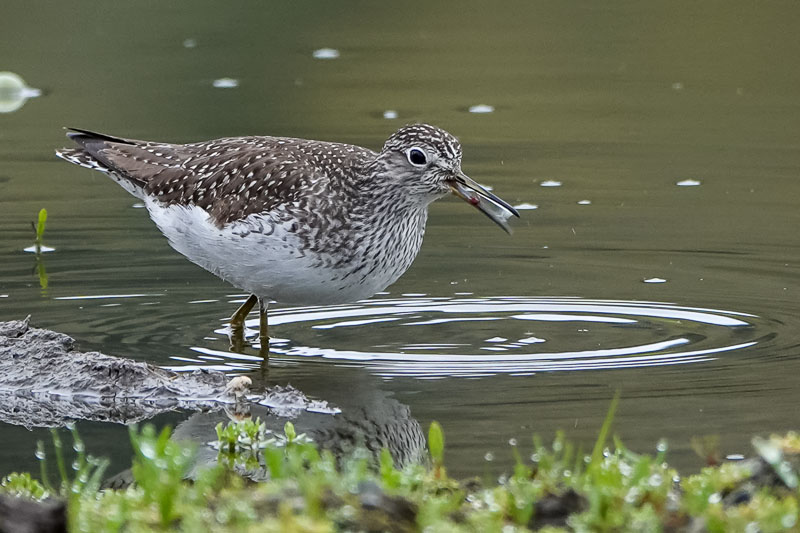
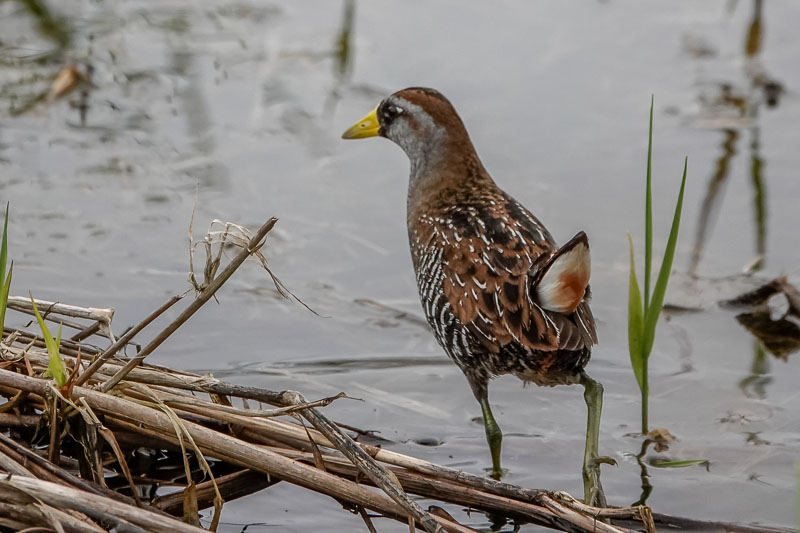 Today we returned to Arlington to try again for the Solitary Sandpiper (SOSA) after hearing that
Anne-Marie W had seen it yesterday afternoon. I was not
excited about the prospect of sitting all afternoon in the car waiting for a bird that might not
show up but went along with the plan anyhow. We brought food and decided we could configure the
camera while we waited. When we pulled up to David's driveway around noon the bird was not present
in its puddle, or so we thought. We had been waiting about 10 minutes when to my surprise, the bird
suddenly appeared. Neither of us had seen it fly in. I told Darchelle "There it is!" at the same
time as her phone rang. It was David calling to tell us that the bird had been in the puddle
since before we arrived and he was concerned that we might give up and leave without seeing it.
Today we returned to Arlington to try again for the Solitary Sandpiper (SOSA) after hearing that
Anne-Marie W had seen it yesterday afternoon. I was not
excited about the prospect of sitting all afternoon in the car waiting for a bird that might not
show up but went along with the plan anyhow. We brought food and decided we could configure the
camera while we waited. When we pulled up to David's driveway around noon the bird was not present
in its puddle, or so we thought. We had been waiting about 10 minutes when to my surprise, the bird
suddenly appeared. Neither of us had seen it fly in. I told Darchelle "There it is!" at the same
time as her phone rang. It was David calling to tell us that the bird had been in the puddle
since before we arrived and he was concerned that we might give up and leave without seeing it.
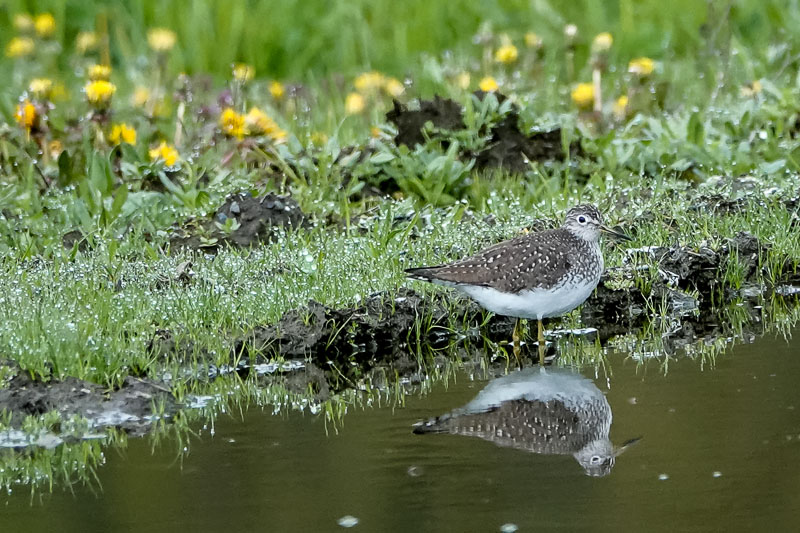
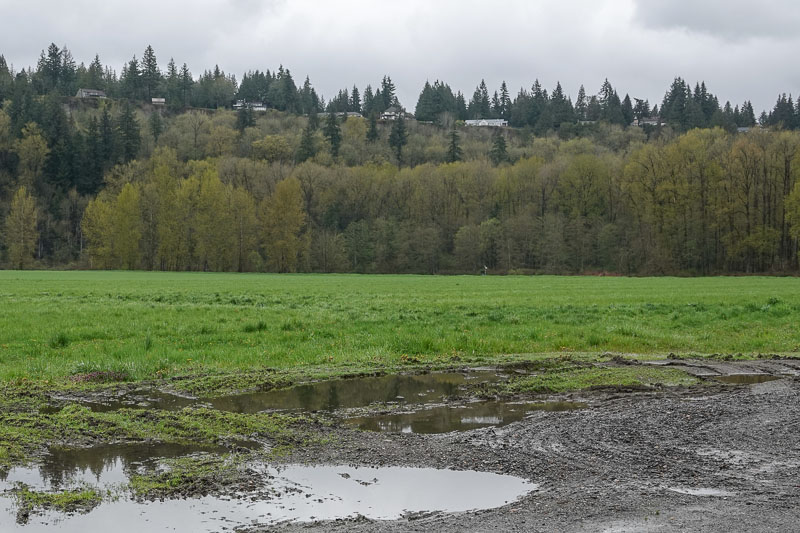
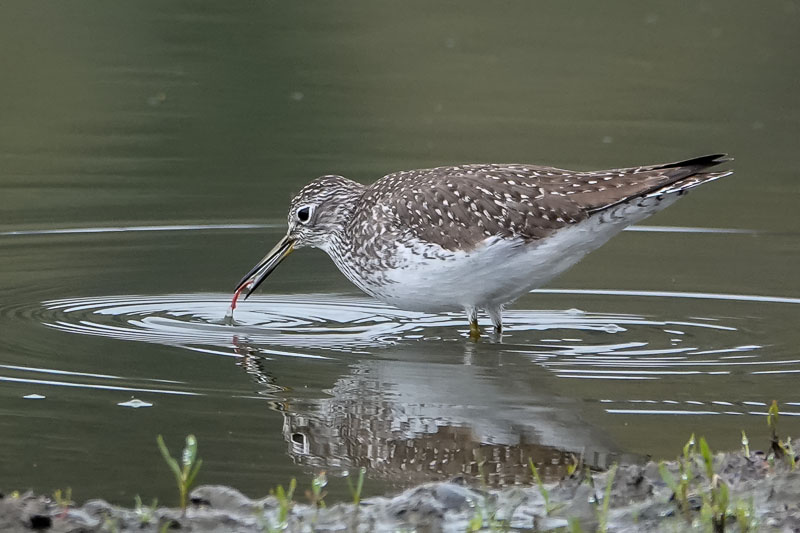 Darchelle took photos while the bird stalked around its puddle plucking small red creatures out
of the water and swallowing them, then took more photos while the bird stood almost motionless on
the far shore for 15 minutes, or maybe longer; we don't know because we got tired of waiting for it
to get active again.
Darchelle took photos while the bird stalked around its puddle plucking small red creatures out
of the water and swallowing them, then took more photos while the bird stood almost motionless on
the far shore for 15 minutes, or maybe longer; we don't know because we got tired of waiting for it
to get active again.
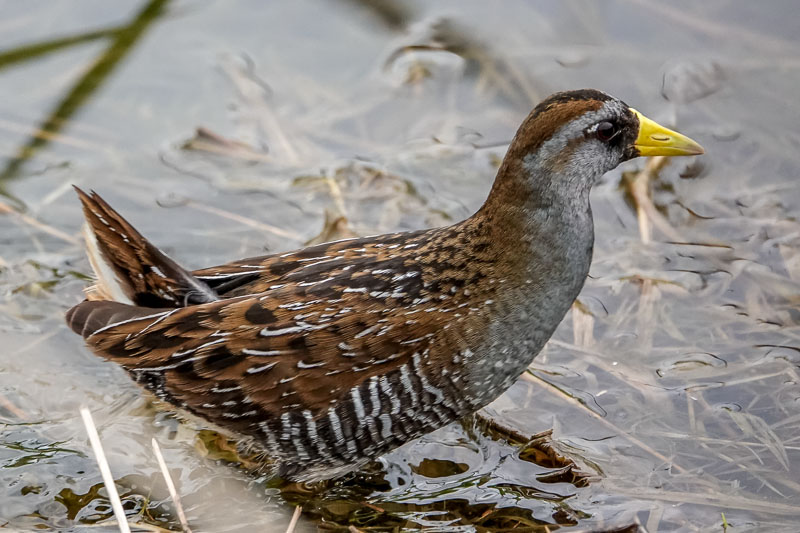
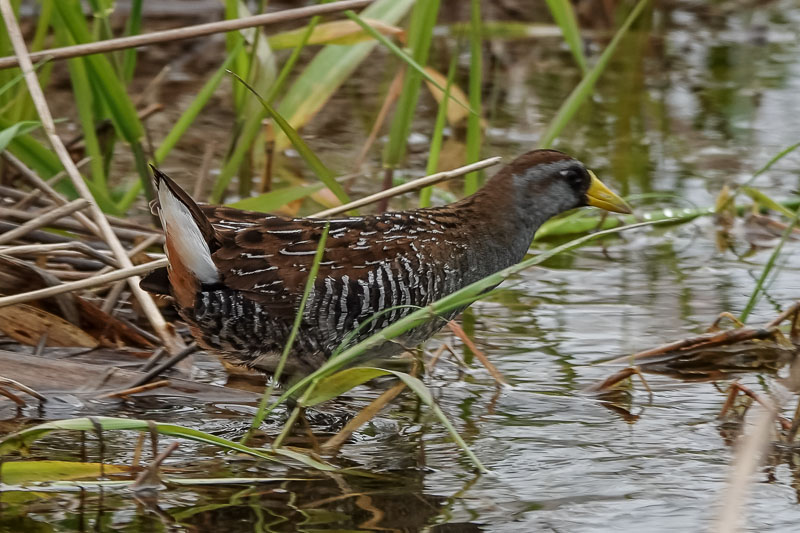
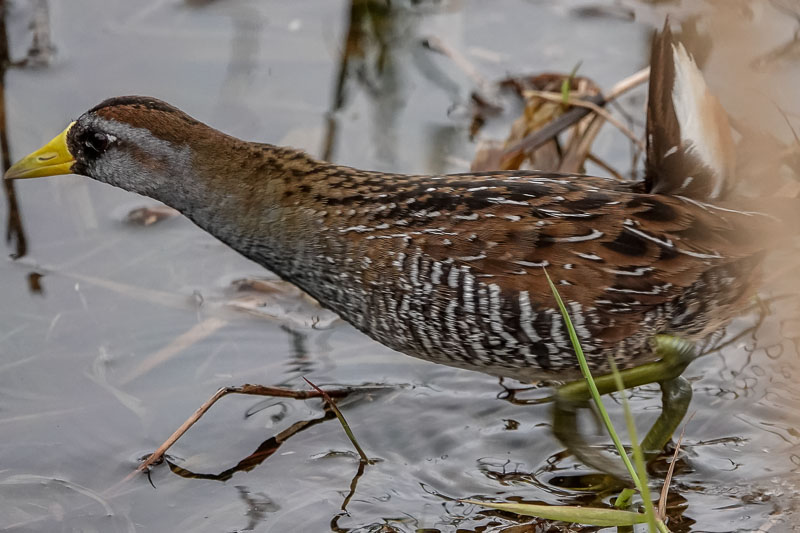 After an unproductive stop at the ever difficult-to-locate 12th St marsh where the grass has grown
too tall to allow birding from the car, we navigated over to Homeacres Road and Ebey Slough where
both a Sandhill crane and a Sora (SORA) had been seen earlier in the day. I waited in the car while
Darchelle found and photographed the Sora (I heard it), then the I spotted the crane while we were
visiting with Steve P who had just driven up to look for it.
The crane was not new for the year for us (though it was my 197th Snohomish County bird), but the
SOSA and SORA were, and the Sandpiper in particular is a bird we would not see most years if we did
not specifically target it.
After an unproductive stop at the ever difficult-to-locate 12th St marsh where the grass has grown
too tall to allow birding from the car, we navigated over to Homeacres Road and Ebey Slough where
both a Sandhill crane and a Sora (SORA) had been seen earlier in the day. I waited in the car while
Darchelle found and photographed the Sora (I heard it), then the I spotted the crane while we were
visiting with Steve P who had just driven up to look for it.
The crane was not new for the year for us (though it was my 197th Snohomish County bird), but the
SOSA and SORA were, and the Sandpiper in particular is a bird we would not see most years if we did
not specifically target it.
Yesterday was Sabbath. We watched church since we were home. It was a good show, featuring a performance by a choir from Loma Linda and a sermon by the youth director of the conference urging the church to adopt (spiritually speaking) their young people. Most people who join the church make the decision to do so between the ages of 4 and 14. They subsequently tend to leave the church during significant life changes - graduating from high school, starting college, graduating from college and becoming parents. If the church intentionally connects with people in those stages of life, maybe they won't leave. It is an important message, affecting the ultimate survival of the institution.
Biological species decline and go extinct if they fail to reproduce. Human communities including churches likewise need to replace members who leave or die so they appropriately concern themselves with strategies to promote member retention and replacement, but that was not the thought I was left with. What I wondered about after the sermon was the relative member retention rates among conservative and liberal sides of the church. In particular, does a conservative Christian worldview tend to promote or inhibit retention of young people. I don't know the answer to that, and at this point I don't care too much either way, but it is an interesting question.
Also interesting was the new series on Netflix which we stayed up too late watching. The Diplomat, combining political intrigue with relational drama and witty dialogue, is very difficult to put down. Sadly, we have only three episodes left and I may not live long enough to see Season 2, not yet announced but potentially dropping in summer of 2024.

Solitary Sandpiper, Arlington

Sora, Everett

Solitary Sandpiper, Arlington

Solitary Sandpiper, Arlington

Solitary Sandpiper, Arlington

Sora, Everett

Sora, Everett

Sora, Everett
Yesterday was Sabbath. We watched church since we were home. It was a good show, featuring a performance by a choir from Loma Linda and a sermon by the youth director of the conference urging the church to adopt (spiritually speaking) their young people. Most people who join the church make the decision to do so between the ages of 4 and 14. They subsequently tend to leave the church during significant life changes - graduating from high school, starting college, graduating from college and becoming parents. If the church intentionally connects with people in those stages of life, maybe they won't leave. It is an important message, affecting the ultimate survival of the institution.
Biological species decline and go extinct if they fail to reproduce. Human communities including churches likewise need to replace members who leave or die so they appropriately concern themselves with strategies to promote member retention and replacement, but that was not the thought I was left with. What I wondered about after the sermon was the relative member retention rates among conservative and liberal sides of the church. In particular, does a conservative Christian worldview tend to promote or inhibit retention of young people. I don't know the answer to that, and at this point I don't care too much either way, but it is an interesting question.
Also interesting was the new series on Netflix which we stayed up too late watching. The Diplomat, combining political intrigue with relational drama and witty dialogue, is very difficult to put down. Sadly, we have only three episodes left and I may not live long enough to see Season 2, not yet announced but potentially dropping in summer of 2024.
4/26/2023 Road Trip

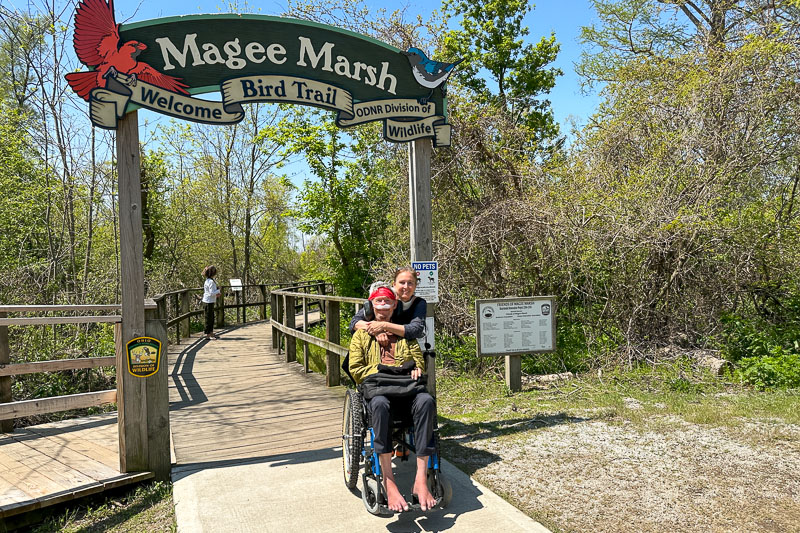
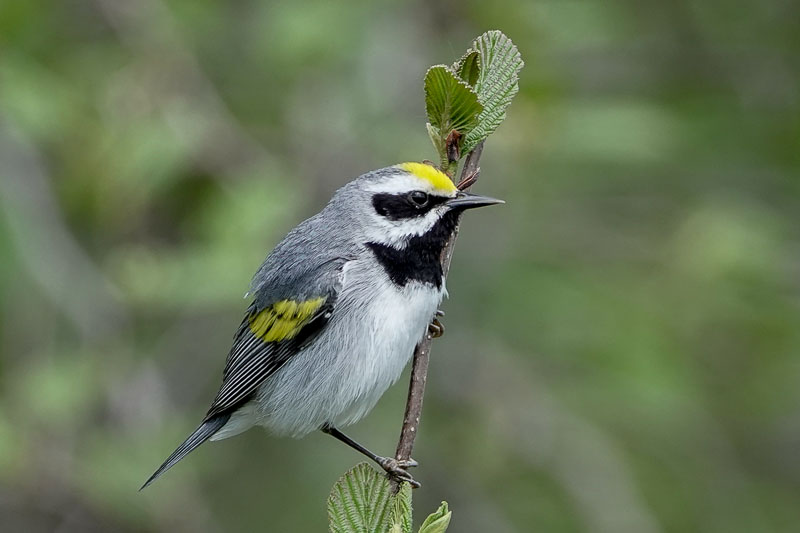 Between April 26 and June 5 we drove across the country and back again to visit family and friends
and to see as many birds as we could along the way. We spent 41 days on the road, drove 8953 miles,
traversed 20 states, saw or heard
295 species of
birds and spent a bunch of money. Here is
our account of our trip.
Between April 26 and June 5 we drove across the country and back again to visit family and friends
and to see as many birds as we could along the way. We spent 41 days on the road, drove 8953 miles,
traversed 20 states, saw or heard
295 species of
birds and spent a bunch of money. Here is
our account of our trip.

On the road again, Cle Elum WA

At Magee Marsh, Oak Harbor OH

Golden-winged Warbler, S Lyman Lake Rd, Parkland WI
6/8/2023 South to Camas (link to here)
Although we are not doing a big year in Washington this year, that does not mean that we are willing to settle for a small year. If there are birds out there that we have not seen yet, we will go see them. To that end, we dedicated this weekend to a tour of the southern half of the state targeting a dozen species, about half of them at least somewhat hard to find due to limited range or abundance in the state.
First up was the Northern Bobwhite, a non-native quail with a small naturalized population along Muck Creek on Joint Base Lewis-McCord east of Olympia. Driving onto the base requires a permit which we have not this year gone to the trouble to obtain, having discovered a year or two ago that 5 the quail can be heard and even seen from the west end of 282nd St South in the small town of Roy. We met Ed and Delia there L+ this morning and together accumulated a list of 38 species including at least one Bobwhite giving its eponymous call. Darchelle got me out of the car into the wheelchair so that I could hear it too. A range fire, not the first one to char the area in the past few years, was still smoldering along Muck Creek and the Bobwhite seemed to have relocated upstream and east of the road.
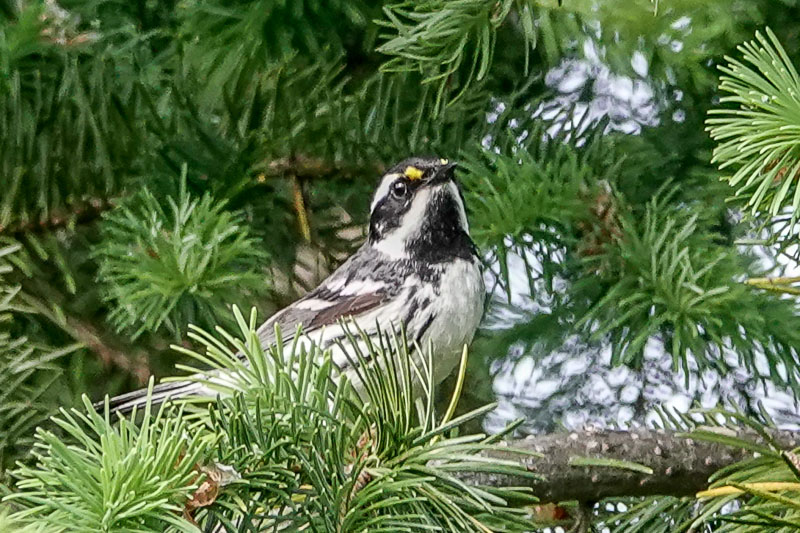
 Ed and Delia were willing to join us in our pursuit of our next target, a Hermit Warbler. For them,
the most challenging aspect of the pursuit would be following us through the maze of secondary roads
between Roy and Olympia. We made a couple of wrong turns in order to keep it interesting for them
but they hung with us and we arrived at the Dryad Cemetery L+ together. Hermit Warblers prefer mature second
growth Douglas Fir forest in the southwest quadrant of the state. They have long nested at nearby
Rainbow Falls State Park but the cemetery was a new location for us. I think we heard one singing
as soon as we drove up to the edge of the woods at the back of the cemetery but Sibley persuaded it
and a friend to come in for a closer look. One of the Hermit Warblers actually perched right outside
my car window but unlike the Black-throat Gray Warbler, did not linger for photos.
Ed and Delia were willing to join us in our pursuit of our next target, a Hermit Warbler. For them,
the most challenging aspect of the pursuit would be following us through the maze of secondary roads
between Roy and Olympia. We made a couple of wrong turns in order to keep it interesting for them
but they hung with us and we arrived at the Dryad Cemetery L+ together. Hermit Warblers prefer mature second
growth Douglas Fir forest in the southwest quadrant of the state. They have long nested at nearby
Rainbow Falls State Park but the cemetery was a new location for us. I think we heard one singing
as soon as we drove up to the edge of the woods at the back of the cemetery but Sibley persuaded it
and a friend to come in for a closer look. One of the Hermit Warblers actually perched right outside
my car window but unlike the Black-throat Gray Warbler, did not linger for photos.
Over at the State Park L+ we stopped for a bite to eat and a few photos. The trees were very tall there and the only Hermit Warbler we heard was high overhead but we piqued the curiosity of a Wilson's Warbler. We also heard a flock of Evening Grosbeaks in the treetops, our 290th species for the state this year.
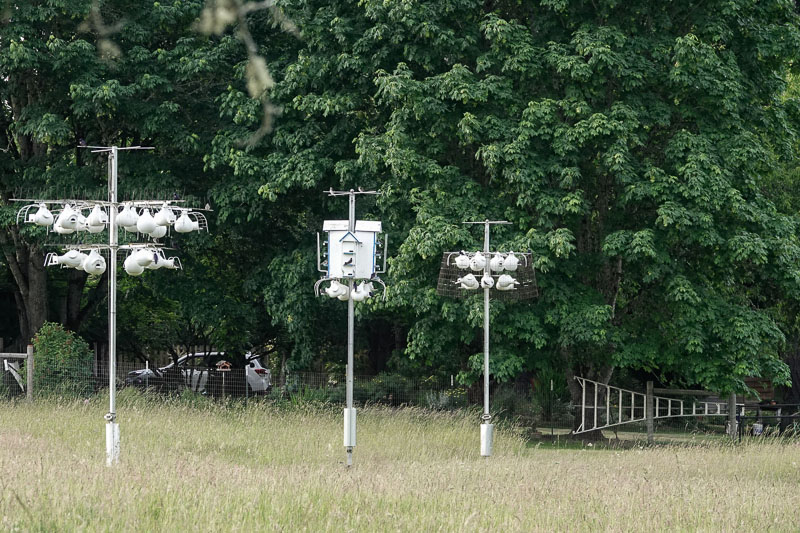
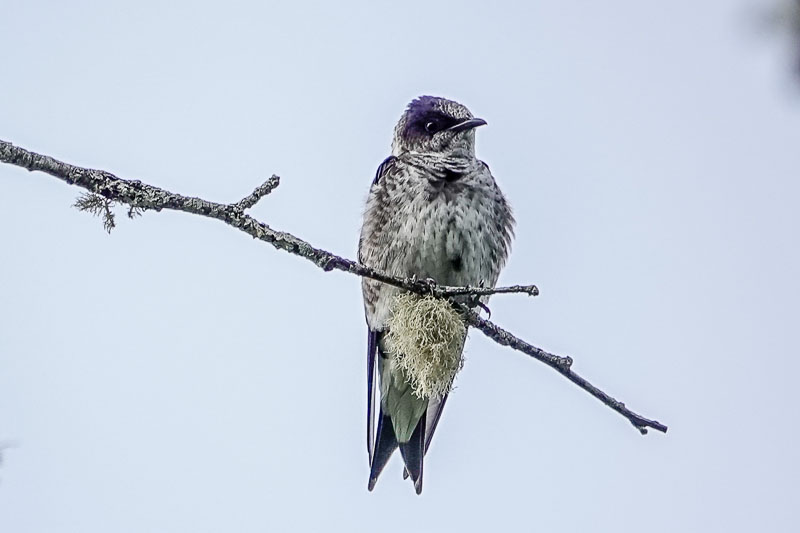
 Ed and Delia persevered with us as far as Ken Buker's Purple Martin Sanctuary L+ down by Silver Lake. We
wanted to see if Ken was still in the martin landlord business because when we had stopped by back
in late March, we had not seen any martin houses. We were relieved to see lots of martin houses
today, along with lots of Purple Martins and Ken himself hale and hearty when we drove up there. He
and Ed got along famously so while they conversed, we birdwatched. I did overhear Ken say at one point
he had 80 or 90 pairs so far with the second-year birds yet to show up.
Ed and Delia persevered with us as far as Ken Buker's Purple Martin Sanctuary L+ down by Silver Lake. We
wanted to see if Ken was still in the martin landlord business because when we had stopped by back
in late March, we had not seen any martin houses. We were relieved to see lots of martin houses
today, along with lots of Purple Martins and Ken himself hale and hearty when we drove up there. He
and Ed got along famously so while they conversed, we birdwatched. I did overhear Ken say at one point
he had 80 or 90 pairs so far with the second-year birds yet to show up.
Although we are not doing a big year in Washington this year, that does not mean that we are willing to settle for a small year. If there are birds out there that we have not seen yet, we will go see them. To that end, we dedicated this weekend to a tour of the southern half of the state targeting a dozen species, about half of them at least somewhat hard to find due to limited range or abundance in the state.
First up was the Northern Bobwhite, a non-native quail with a small naturalized population along Muck Creek on Joint Base Lewis-McCord east of Olympia. Driving onto the base requires a permit which we have not this year gone to the trouble to obtain, having discovered a year or two ago that 5 the quail can be heard and even seen from the west end of 282nd St South in the small town of Roy. We met Ed and Delia there L+ this morning and together accumulated a list of 38 species including at least one Bobwhite giving its eponymous call. Darchelle got me out of the car into the wheelchair so that I could hear it too. A range fire, not the first one to char the area in the past few years, was still smoldering along Muck Creek and the Bobwhite seemed to have relocated upstream and east of the road.

Black-throat Gray Warbler, Dryad Cemetery

Wilson's Warbler, Rainbow Falls State Park
Over at the State Park L+ we stopped for a bite to eat and a few photos. The trees were very tall there and the only Hermit Warbler we heard was high overhead but we piqued the curiosity of a Wilson's Warbler. We also heard a flock of Evening Grosbeaks in the treetops, our 290th species for the state this year.

Ken Buker's Purple Martin Sanctuary, Silver Lake

Purple Martin, Silver Lake

At the Best Western in Camas
6/9/2023 Klickitat to Biscuit Ridge (link to here)

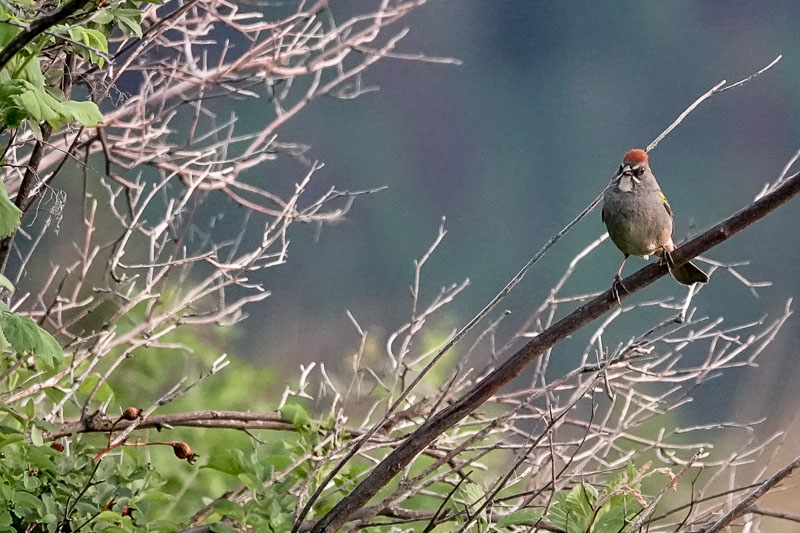 The temperature was in the mid-50s and it was raining when we checked out of the Best Western in
Camas but we stopped anyhow to bird in several places in the gorge between Stephenson and Lyle.
Steady light rain, few birds, no photos.
The temperature was in the mid-50s and it was raining when we checked out of the Best Western in
Camas but we stopped anyhow to bird in several places in the gorge between Stephenson and Lyle.
Steady light rain, few birds, no photos.

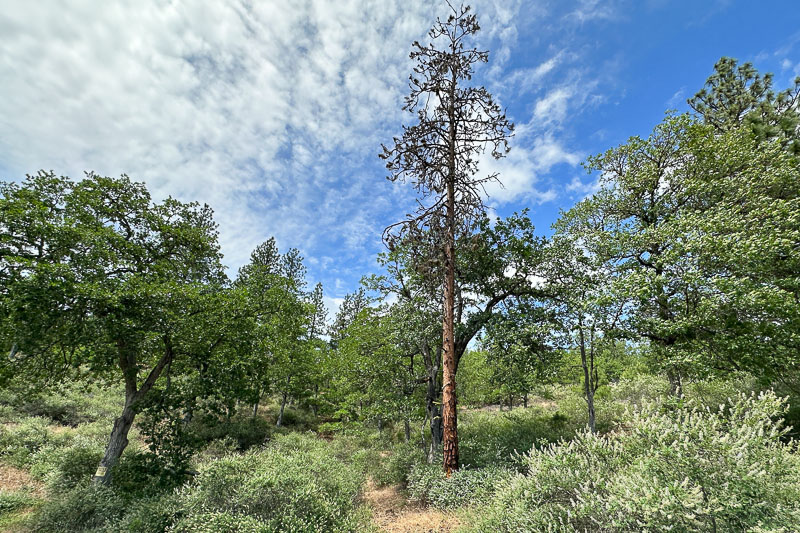
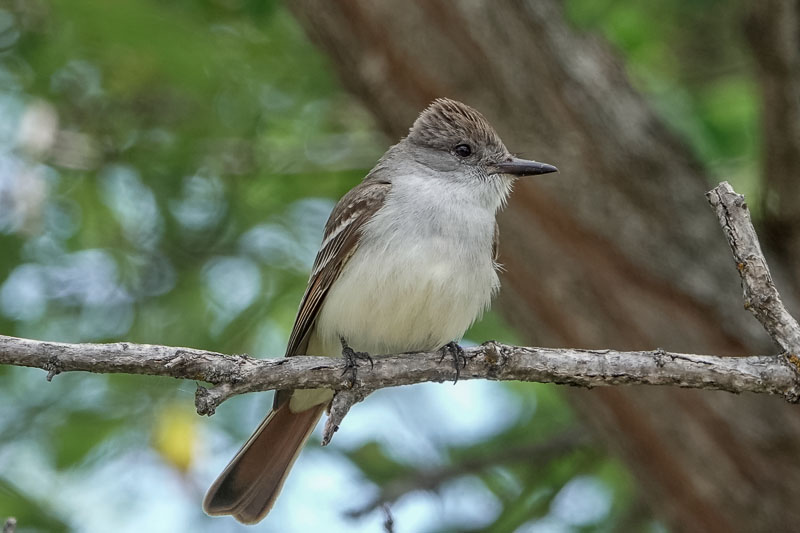 The weather dried out as we drove up the Klickitat
River to the
hillside L+ which supports Washington's only known breeding colony of Blue-gray Gnatcatchers.
Perhaps they are doing well this year because they seemed to be easier to find than usual.
Darchelle loves their "angry bird"
aspect so she took lots of photos.
The weather dried out as we drove up the Klickitat
River to the
hillside L+ which supports Washington's only known breeding colony of Blue-gray Gnatcatchers.
Perhaps they are doing well this year because they seemed to be easier to find than usual.
Darchelle loves their "angry bird"
aspect so she took lots of photos.
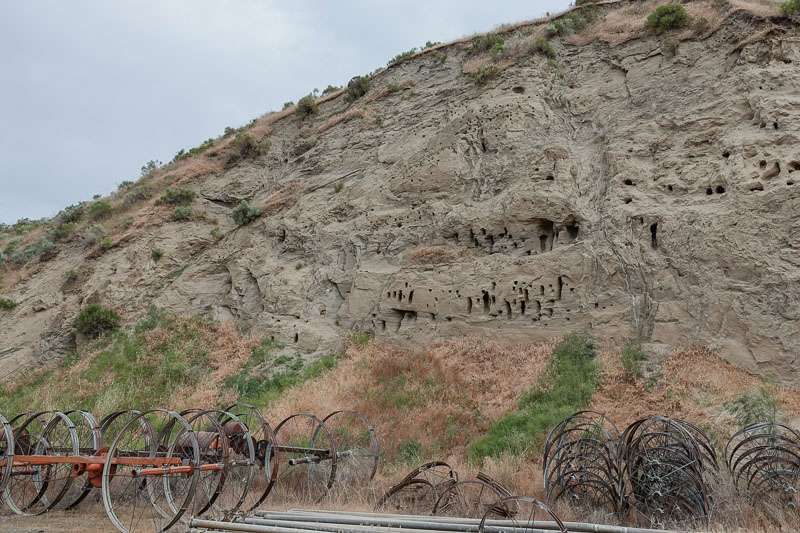

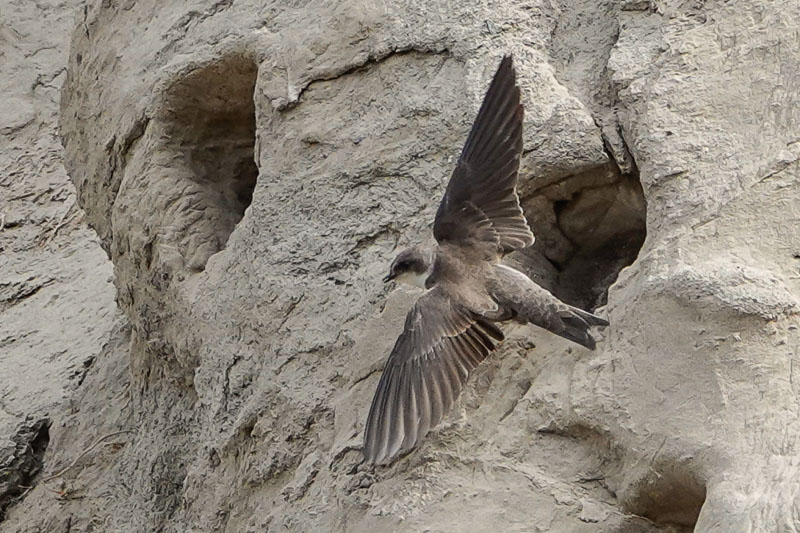 Our next stop was the Bank Swallow colony in Lowden L+. As we anticipated, the swallows, species #295, were home. I have
long wanted to visit that remnant outcrop of Touchet Bed + rhythmites in Lowden and photograph the Bank
Swallows that nest there; today we did.
Our next stop was the Bank Swallow colony in Lowden L+. As we anticipated, the swallows, species #295, were home. I have
long wanted to visit that remnant outcrop of Touchet Bed + rhythmites in Lowden and photograph the Bank
Swallows that nest there; today we did.
One of the more intriguing characteristics of the Touchet Formation is the presence of sheeted clastic dikes + - layered veins of sediment - cutting through the horizontal Touchet beds. As the article observes, these differ from typical sediment dikes in their sheeted structure and association not with earthquakes but with the same massive floods which deposited the Touchet beds themselves. These dikes were injected into fractures in the Touchet beds by the pressure of the overlying water, with each "sheet" representing a separate injection event.
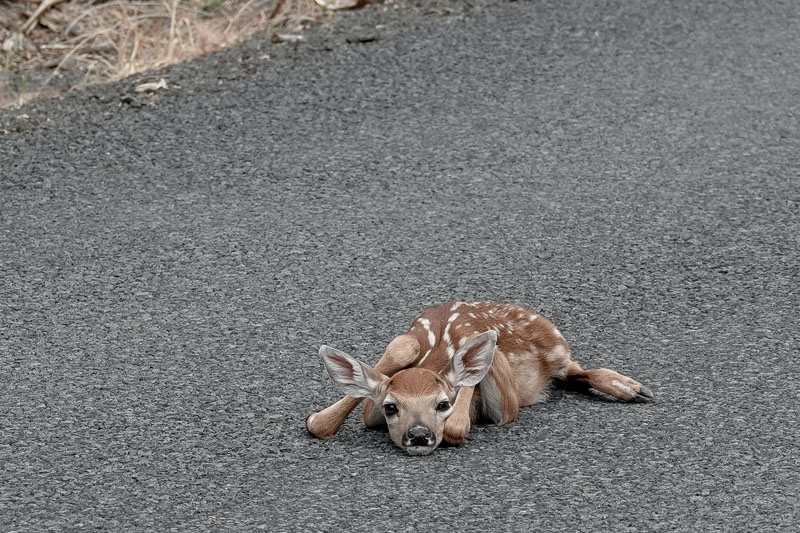
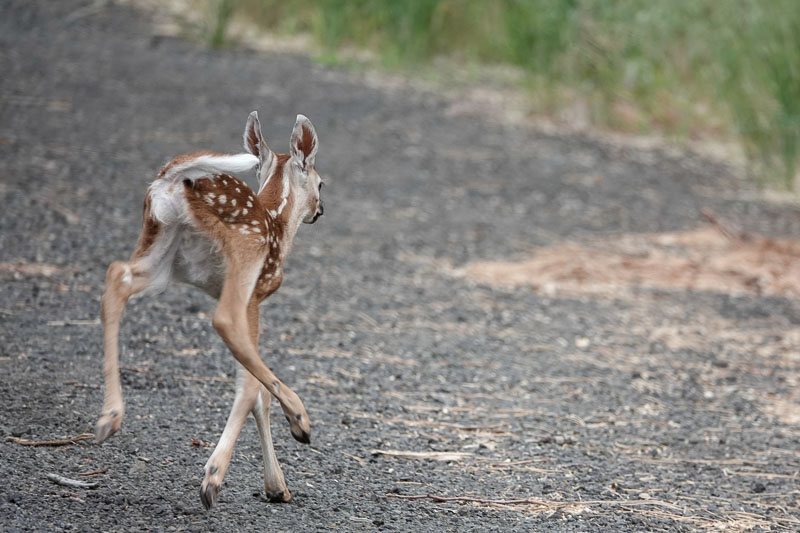
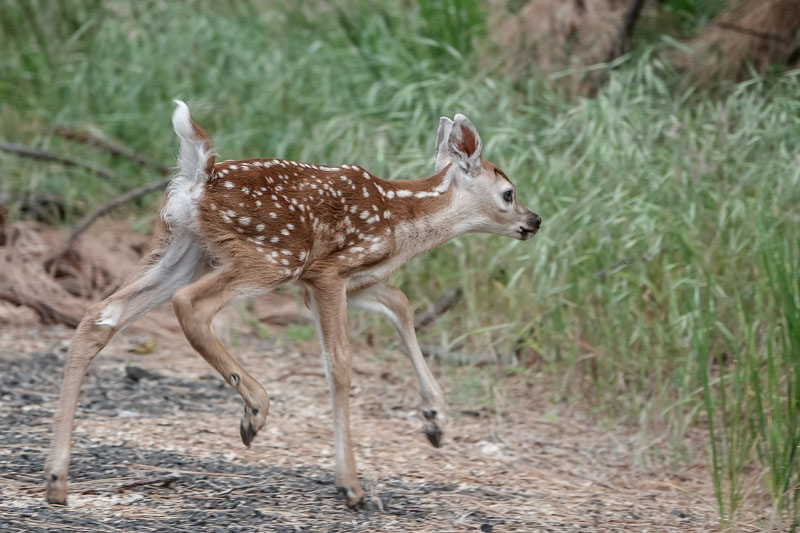 Our next target was another rare species in Washington, the Green-tailed Towhee. They nest in
patches of dense brush on steep slopes above about 4000 feet in the Blue Mountains and are most
easily seen along Biscuit Ridge and North fork Coppei Creek Roads east of the town of Dixie. We
were on our way up to Biscuit Ridge when we startled a White-tail doe with her fawn. Mom bounded
off into the bushes but her baby just collapsed on the pavement, apparently confident that its
camouflage would conceal it. Only when Darchelle got out of the car to take photos did it resort to
plan B.
Our next target was another rare species in Washington, the Green-tailed Towhee. They nest in
patches of dense brush on steep slopes above about 4000 feet in the Blue Mountains and are most
easily seen along Biscuit Ridge and North fork Coppei Creek Roads east of the town of Dixie. We
were on our way up to Biscuit Ridge when we startled a White-tail doe with her fawn. Mom bounded
off into the bushes but her baby just collapsed on the pavement, apparently confident that its
camouflage would conceal it. Only when Darchelle got out of the car to take photos did it resort to
plan B.


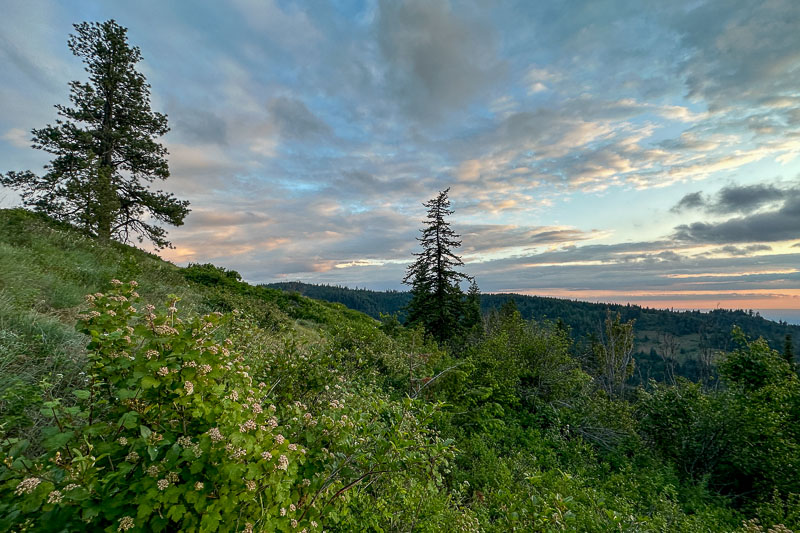 By the time was reached the top of Biscuit Ridge L+ the hour was getting late enough that I thought the towhees
might have gone to bed but they waited up for us. We were pretty sure we heard one at the checklist
location; a few minutes later Gavin, Zeke and Caleb from Walla Walla actually saw that bird but by
then Darchelle and I had driven a mile or two back down the road to the spot where I had seen them
in 2016.
Darchelle found them there again.
By the time was reached the top of Biscuit Ridge L+ the hour was getting late enough that I thought the towhees
might have gone to bed but they waited up for us. We were pretty sure we heard one at the checklist
location; a few minutes later Gavin, Zeke and Caleb from Walla Walla actually saw that bird but by
then Darchelle and I had driven a mile or two back down the road to the spot where I had seen them
in 2016.
Darchelle found them there again.
While looking for the towhee we flushed a Dusky Grouse in exactly the same spot where we saw them displaying last year. That was a nice bonus! In our experience they are not easy to find in the Blue Mountains.

Blue-gray Gnatcatcher, Klickitat

Green-tailed Towhee, Biscuit Ridge

Blue-gray Gnatcatcher, Klickitat

Blue-gray Gnatcatcher habitat, Klickitat

Ash-throated Flycatcher, Klickitat

Touchet Bed outcrop, Lowden

Sheeted Clastic Dike in Touchet Bed sediment, Lowden

Bank Swallow, Lowden
One of the more intriguing characteristics of the Touchet Formation is the presence of sheeted clastic dikes + - layered veins of sediment - cutting through the horizontal Touchet beds. As the article observes, these differ from typical sediment dikes in their sheeted structure and association not with earthquakes but with the same massive floods which deposited the Touchet beds themselves. These dikes were injected into fractures in the Touchet beds by the pressure of the overlying water, with each "sheet" representing a separate injection event.

White-tailed Deer fawn, Biscuit Ridge Road

White-tailed Deer fawn, Biscuit Ridge Road

White-tailed Deer fawn, Biscuit Ridge Road

Dusky Grouse, Biscuit Ridge

Green-tailed Towhee, Biscuit Ridge

Green-tailed Towhee habitat, Biscuit Ridge
While looking for the towhee we flushed a Dusky Grouse in exactly the same spot where we saw them displaying last year. That was a nice bonus! In our experience they are not easy to find in the Blue Mountains.
6/10/2023 North to Coppei Ck (link to here)
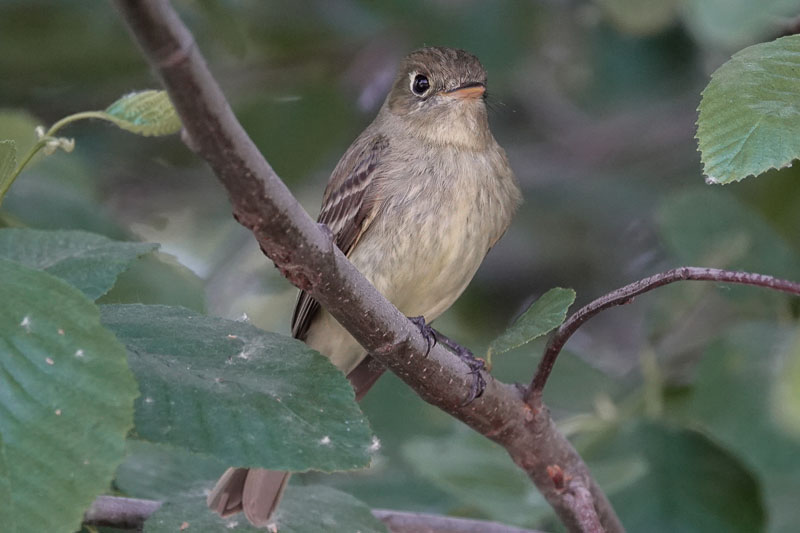

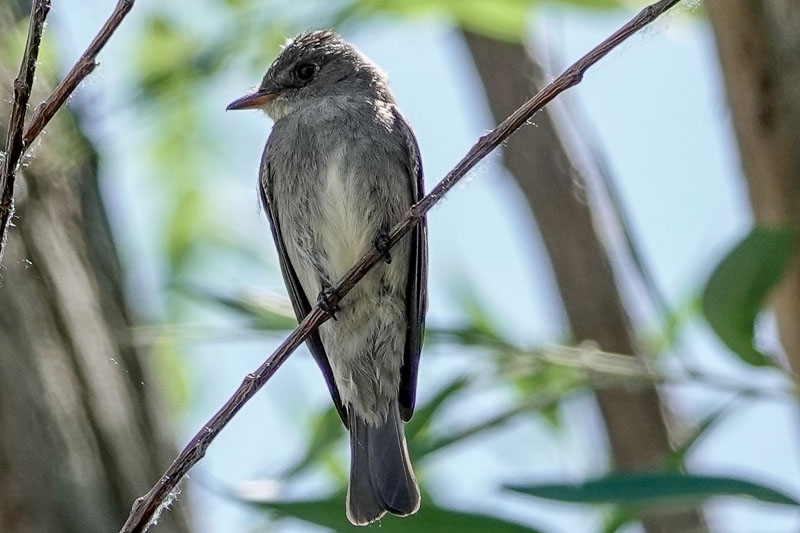 We stayed with Darchelle's folks in College Place but we slept in and I'm not sure we even saw
them before they left for church. Knowing they were engaged for the afternoon, we drove up to the
North Fork of
Coppei Creek L+ in search of a year bird which by the end of the year would no longer
count as a year bird - the Cordilleran Flycatcher. Sometime in the fall it was lumped back in
with the Pacific Slope Flycatcher to become the Western Flycatcher it once was. Now subspecies,
the two forms are identical in appearance but their songs differ. It took us a while but we
eventually heard the bird we were looking for, downstream a few miles at the
McCown Bridge L+.
We stayed with Darchelle's folks in College Place but we slept in and I'm not sure we even saw
them before they left for church. Knowing they were engaged for the afternoon, we drove up to the
North Fork of
Coppei Creek L+ in search of a year bird which by the end of the year would no longer
count as a year bird - the Cordilleran Flycatcher. Sometime in the fall it was lumped back in
with the Pacific Slope Flycatcher to become the Western Flycatcher it once was. Now subspecies,
the two forms are identical in appearance but their songs differ. It took us a while but we
eventually heard the bird we were looking for, downstream a few miles at the
McCown Bridge L+.
.

Western Flycatcher, North fork Coppei Creek

Eastern Kingbird, North fork Coppei Creek

Western Wood Peewee, North fork Coppei Creek
6/11/2023 West to Gig Harbor (and home) (link to here)
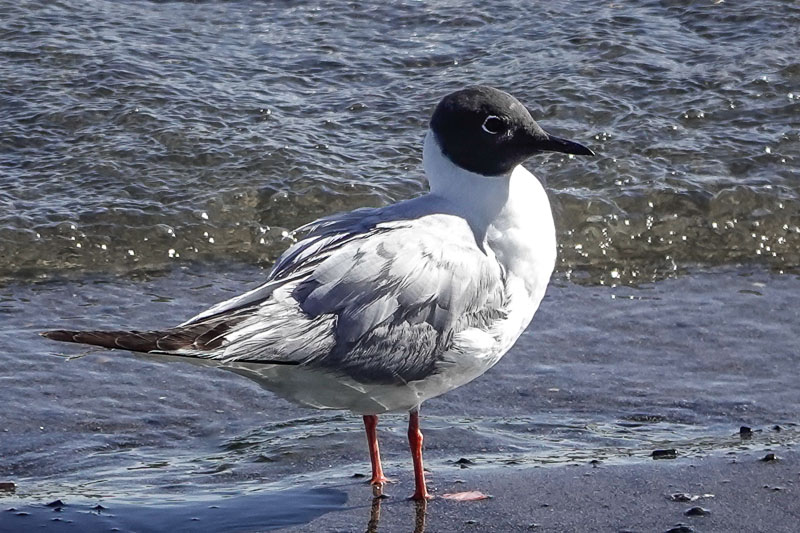
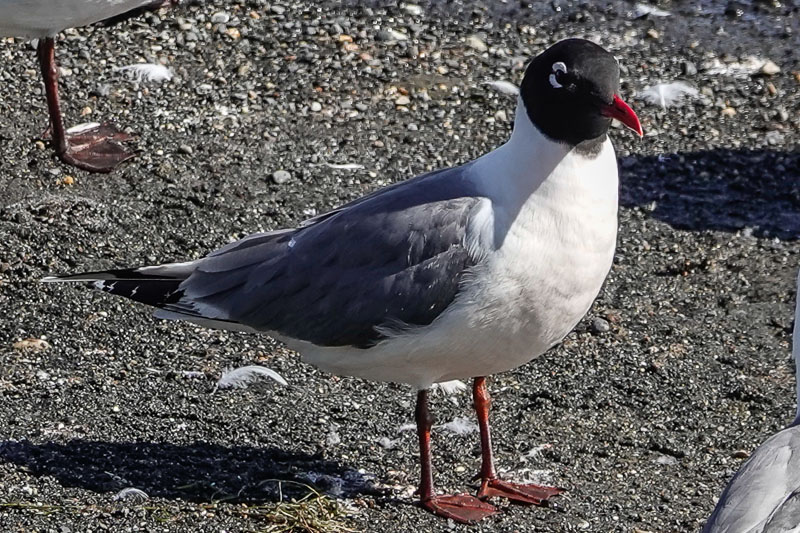
 Cara B's discovery of a singing male Chestnut-sided Warbler
in the woods near Gig Harbor yesterday got us out of bed and on the road early this morning, at
least by our standards. The drive would only take us about five hours but we had a few stops to
make along the way. The first of those was the Clover Island Marina L+ in Kennewick. There Darchelle had good
views of both juvenile and adult Franklin's Gulls preening on the beach below the parking lot.
My views from the car were not nearly as good but I did not feel like getting out and Darchelle got
photos for me.
Cara B's discovery of a singing male Chestnut-sided Warbler
in the woods near Gig Harbor yesterday got us out of bed and on the road early this morning, at
least by our standards. The drive would only take us about five hours but we had a few stops to
make along the way. The first of those was the Clover Island Marina L+ in Kennewick. There Darchelle had good
views of both juvenile and adult Franklin's Gulls preening on the beach below the parking lot.
My views from the car were not nearly as good but I did not feel like getting out and Darchelle got
photos for me.
Although not the fastest route to Gig Harbor, taking Highway 410 over Chinook Pass allowed us to pick up two more species along the way, a Lewis's Woodpecker at Oak Creek and a Canada Jay at the pass itself, where we introduced several other people to the joys of feeding wild birds by hand. The jay was our 300th Washington bird for the year, a milestone we have usually reached a week earlier except last year, when we reached 300 in mid-May.
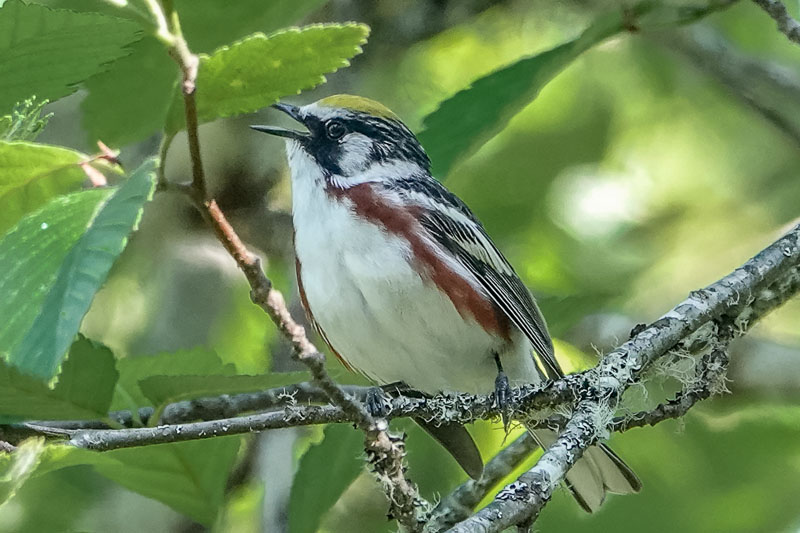
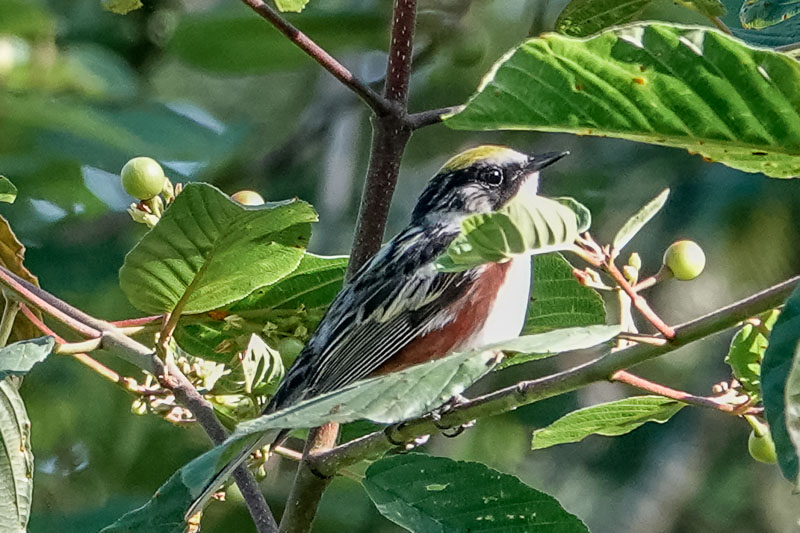
 The Chestnut-sided Warbler was not accessible by road. Knowing that in advance, Darchelle had spent
a considerable amount of time in communication with Cara to determine how best to reach the bird
with the wheelchair. The route they decided on was the shortest but it began with about 100 yards of
single-track from which Cara cut back the brush on either side to make it easier for us. Darchelle
also recruited Mason M to help us negotiate that section.
Thanks to both of them, I got to see the bird!
The Chestnut-sided Warbler was not accessible by road. Knowing that in advance, Darchelle had spent
a considerable amount of time in communication with Cara to determine how best to reach the bird
with the wheelchair. The route they decided on was the shortest but it began with about 100 yards of
single-track from which Cara cut back the brush on either side to make it easier for us. Darchelle
also recruited Mason M to help us negotiate that section.
Thanks to both of them, I got to see the bird!
When we reached the patch of woods L+ where the bird had been reported, I recognized it. I had run my 32nd marathon there back in 2007 and my 128th there in 2011. Back then the race director had called it the Crescent Forest but a more recent blog called it the 1000 Acre Woods +.
During my 2011 marathon I probably kept a bird list because I remember noting Wilson's, Orange-crowned and MacGillivray's warblers, all of which we heard today along with the Chestnut-sided and 26 other species. The birds were quite active for late afternoon. The birders were too; a half dozen other people showed up while we were there including a couple with a small baby and a woman in a white dress. I sat in my chair watching the birds and the birders and enjoyed decent views of both.

Bonaparte's Gull, Clover Island Marina, Kennewick

Franklin's Gull, Clover Island Marina, Kennewick

Canada Jay, Chinook Pass
Although not the fastest route to Gig Harbor, taking Highway 410 over Chinook Pass allowed us to pick up two more species along the way, a Lewis's Woodpecker at Oak Creek and a Canada Jay at the pass itself, where we introduced several other people to the joys of feeding wild birds by hand. The jay was our 300th Washington bird for the year, a milestone we have usually reached a week earlier except last year, when we reached 300 in mid-May.

Chestnut-sided Warbler, Gig Harbor

Chestnut-sided Warbler, Gig Harbor

Darchelle, Mason and me, Gig Harbor
When we reached the patch of woods L+ where the bird had been reported, I recognized it. I had run my 32nd marathon there back in 2007 and my 128th there in 2011. Back then the race director had called it the Crescent Forest but a more recent blog called it the 1000 Acre Woods +.
During my 2011 marathon I probably kept a bird list because I remember noting Wilson's, Orange-crowned and MacGillivray's warblers, all of which we heard today along with the Chestnut-sided and 26 other species. The birds were quite active for late afternoon. The birders were too; a half dozen other people showed up while we were there including a couple with a small baby and a woman in a white dress. I sat in my chair watching the birds and the birders and enjoyed decent views of both.
6/12/2023 Cle Elum (link to here)
Another rare warbler, a Magnolia this time, turned up in Cle Elum yesterday. We learned about it from Cara and drove over to look for it as soon as she verified that the report was legitimate. It took us a while to find the correct location, a vacation home in a patch of pine forest L+ with an understory of tall bushes and a diverse community of birds which unfortunately no longer included the warbler. I sat in the driveway monitoring my visual slice of the landscape while Darchelle searched the neighborhood. The day grew warm and the birds grew quiet. A chipmunk scolded me from a pile of logs on the far side of the driveway. Two orange butterflies squabbled over an opening between the bushes. A yellowjacket sniffed around my bare ankle, left, returned and left again, this time for good. After about five hours, so did we.
Another rare warbler, a Magnolia this time, turned up in Cle Elum yesterday. We learned about it from Cara and drove over to look for it as soon as she verified that the report was legitimate. It took us a while to find the correct location, a vacation home in a patch of pine forest L+ with an understory of tall bushes and a diverse community of birds which unfortunately no longer included the warbler. I sat in the driveway monitoring my visual slice of the landscape while Darchelle searched the neighborhood. The day grew warm and the birds grew quiet. A chipmunk scolded me from a pile of logs on the far side of the driveway. Two orange butterflies squabbled over an opening between the bushes. A yellowjacket sniffed around my bare ankle, left, returned and left again, this time for good. After about five hours, so did we.
6/13-15/2023 Orcas Island (link to here)


 .
.


 .
.

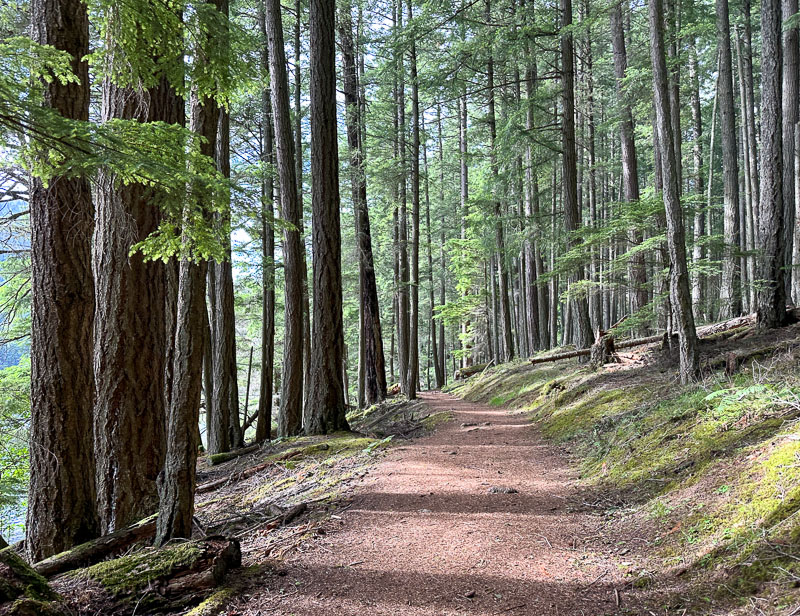
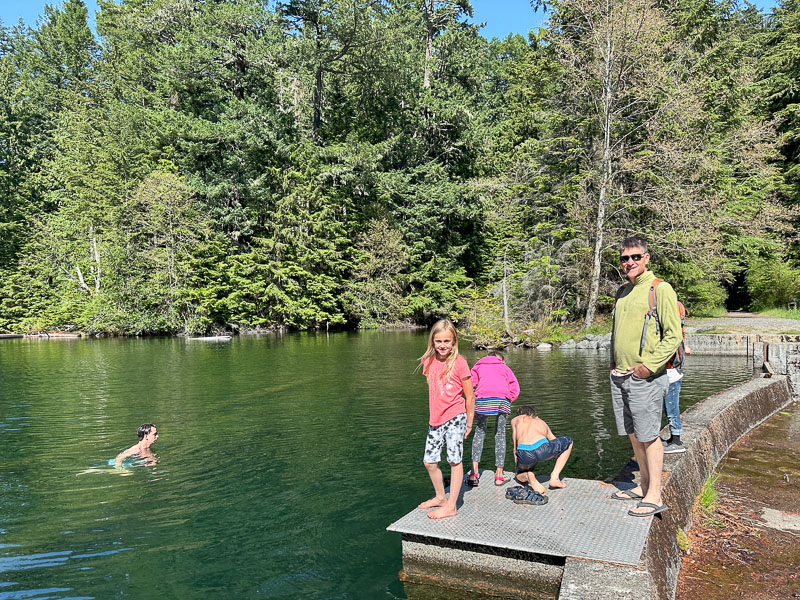

AirBnB, Eastsound

AirBnB, Eastsound

North Beach

Donna, Orcas Island

Giving thanks, Orcas Island

Richard, Orcas Island

At the beach, Eastsound

Mountain Lake trail, Orcas Island

At Mountain Lake, Orcas Island
6/16/2023 Washington Pass (link to here)
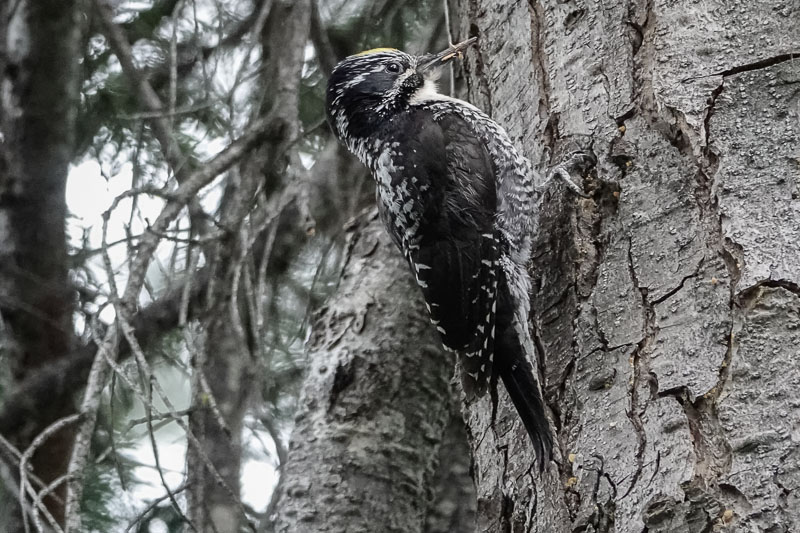
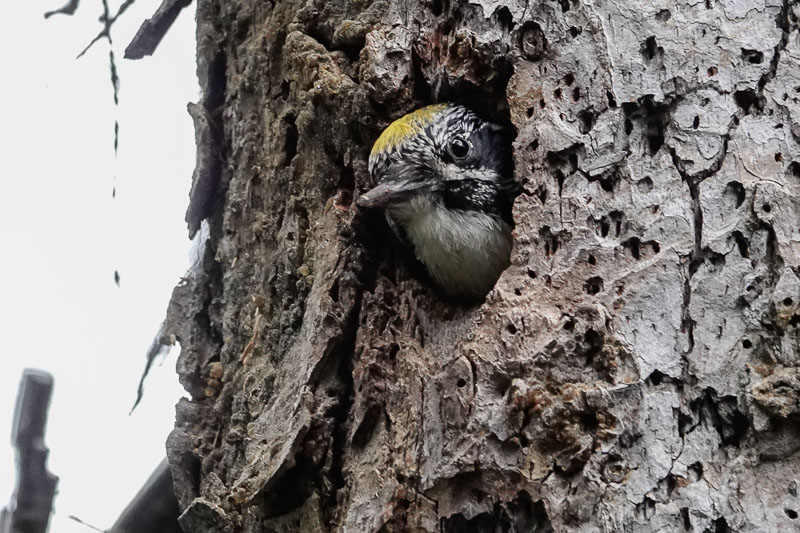
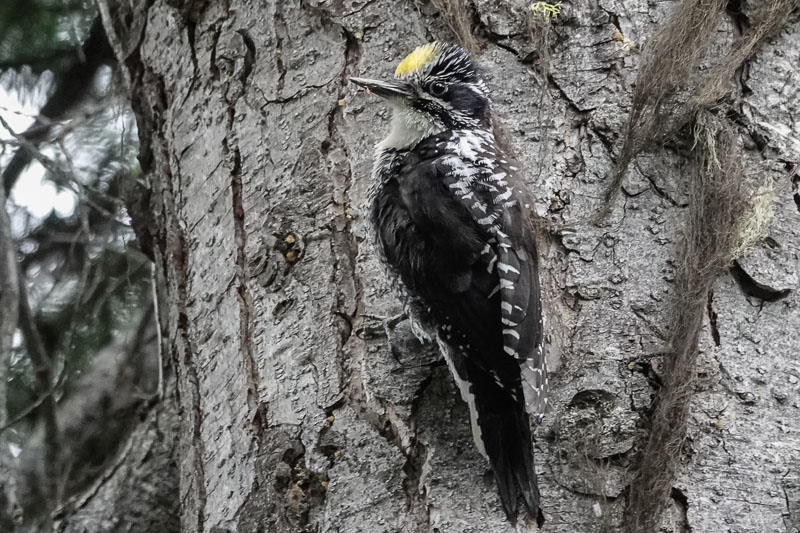 Leaving Orcas this morning, Sally and family had decided to head straight home so we decided,
since we were already an hour north of Seattle, to run up to Washington Pass L+ where an American Three-toed Woodpecker had
been excavating a nest hole in a snag right next to the trail out to the overlook. Darchelle found
the woodpecker immediately and mosquitoes found me immediately after she got out the car to
photograph it. Deterred by the bugs, I stayed in the car while Darchelle pointed the woodpecker out
to me.
Leaving Orcas this morning, Sally and family had decided to head straight home so we decided,
since we were already an hour north of Seattle, to run up to Washington Pass L+ where an American Three-toed Woodpecker had
been excavating a nest hole in a snag right next to the trail out to the overlook. Darchelle found
the woodpecker immediately and mosquitoes found me immediately after she got out the car to
photograph it. Deterred by the bugs, I stayed in the car while Darchelle pointed the woodpecker out
to me.
On our way out of the parking lot I spotted a plump reddish bird at the top of a tall snag. Darchelle got binoculars on it and identified it as a Pine Grosbeak. It flew before she could get a photo of it so I was unable to confirm her ID. The color had seemed a bit orange to me, so although we counted it for the year I retained a nagging suspicion that it might have been a Robin. Darchelle was probably right and in any case, we would see another five months later in Neah Bay.
On our way home we paused at a park in Darrington to watch two Black Swifts gliding overhead. Species #305 and our only sighting of the year.

American Three-toed Woodpecker, Washington Pass

American Three-toed Woodpecker, Washington Pass

American Three-toed Woodpecker, Washington Pass
On our way out of the parking lot I spotted a plump reddish bird at the top of a tall snag. Darchelle got binoculars on it and identified it as a Pine Grosbeak. It flew before she could get a photo of it so I was unable to confirm her ID. The color had seemed a bit orange to me, so although we counted it for the year I retained a nagging suspicion that it might have been a Robin. Darchelle was probably right and in any case, we would see another five months later in Neah Bay.
On our way home we paused at a park in Darrington to watch two Black Swifts gliding overhead. Species #305 and our only sighting of the year.
6/18/2023 Reunion (link to here)
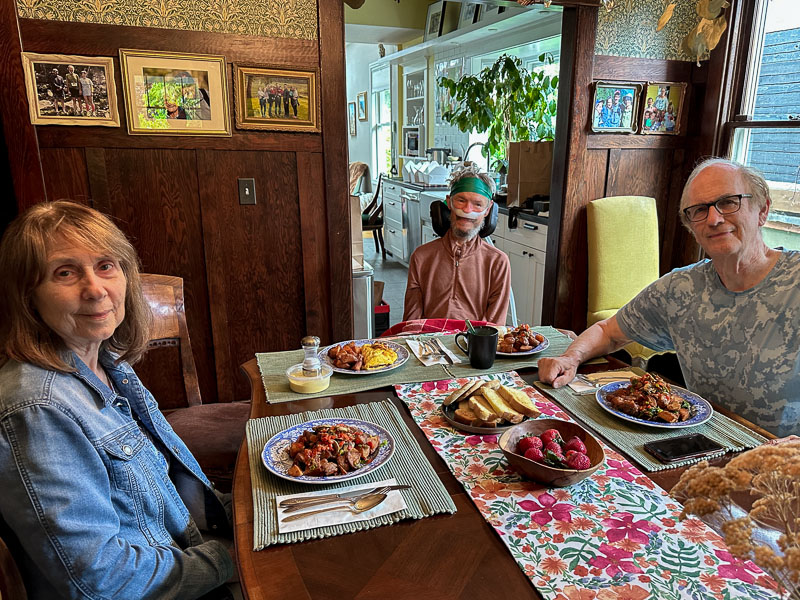
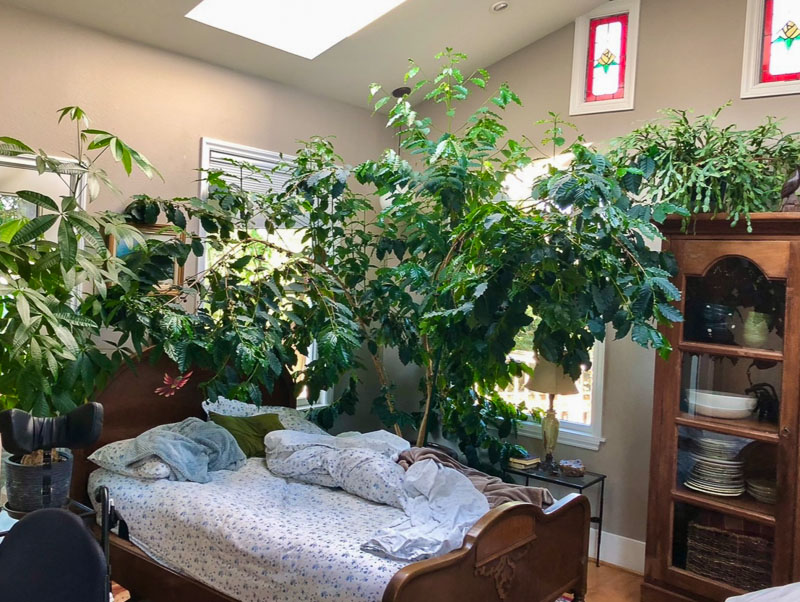
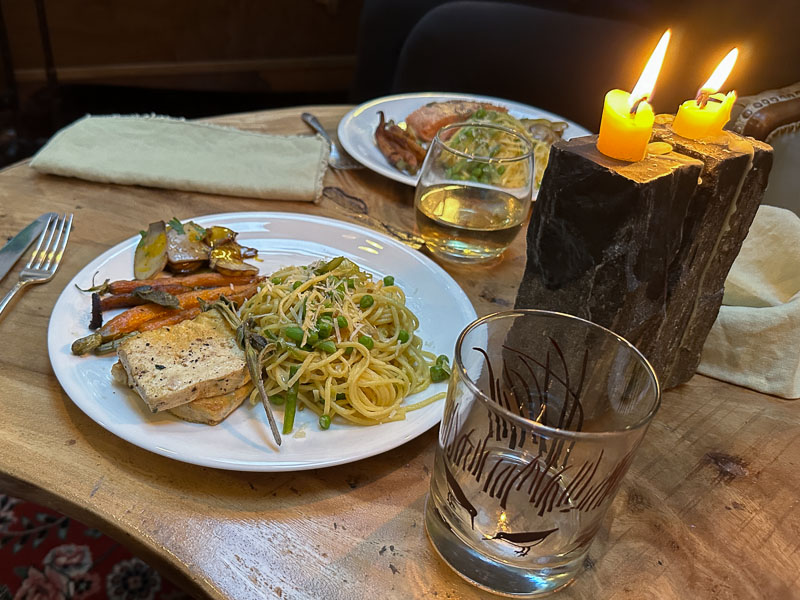 Darchelle's folks spent Sabbath with us after Orcas, leaving just in time to make room for Daniel
and Caroline who flew up to Seattle to consolidate Daniel's wine collection and of course, to visit.
This evening David came over and Daniel and Caroline fixed dinner. Caroline prepared fresh pasta and
Daniel broiled salt-rubbed King Salmon for the pescavores and herbed tofu for the vegetarians. The
salmon was amazing, creamy, translucent and sweet inside a savory crust. The Fremont 2014 barrel-aged
Abominable Ale, while perhaps not the best beverage to accompany salmon, was probably one of the best
stouts ever brewed. Daniel had been saving it for a special occasion.
Darchelle's folks spent Sabbath with us after Orcas, leaving just in time to make room for Daniel
and Caroline who flew up to Seattle to consolidate Daniel's wine collection and of course, to visit.
This evening David came over and Daniel and Caroline fixed dinner. Caroline prepared fresh pasta and
Daniel broiled salt-rubbed King Salmon for the pescavores and herbed tofu for the vegetarians. The
salmon was amazing, creamy, translucent and sweet inside a savory crust. The Fremont 2014 barrel-aged
Abominable Ale, while perhaps not the best beverage to accompany salmon, was probably one of the best
stouts ever brewed. Daniel had been saving it for a special occasion.

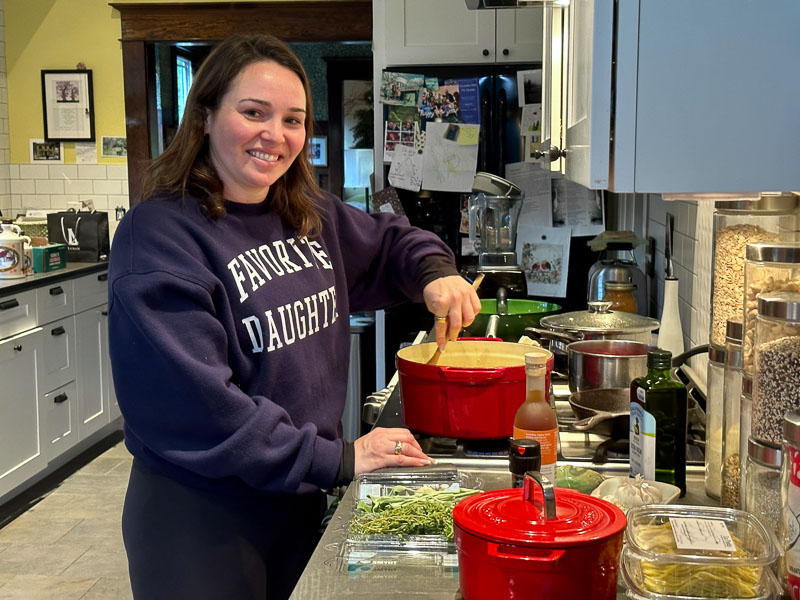
 We all ate dinner in the Jungle Room with our plates in our laps. I don't remember what we talked
about; perhaps it doesn't matter. We were together.
We all ate dinner in the Jungle Room with our plates in our laps. I don't remember what we talked
about; perhaps it doesn't matter. We were together.

Breakfast with Richard and Donna

The Coffee Tree in the Jungle Room

Dinner by Daniel and Caroline

The Kids in the Kitchen

Caroline in the Kitchen

David, Daniel and Daddy
6/22/2023 Tiffany Meadows (link to here)
Of the resident land birds we can reasonably expect to see in Washington this year, we are missing only three - Spruce Grouse, American Goshawk and Boreal Chickadee. All three can be found along a one mile stretch of forest road between Freezout Pass and Tiffany Meadows in Okanogan County north of Winthrop. Knowing we would be fortunate to find even one of those species, we headed up there today anyhow on an outing made more appealing by the prospect of picking up the Indigo Bunting which Joel B-P discovered a few days ago in Marblemount.
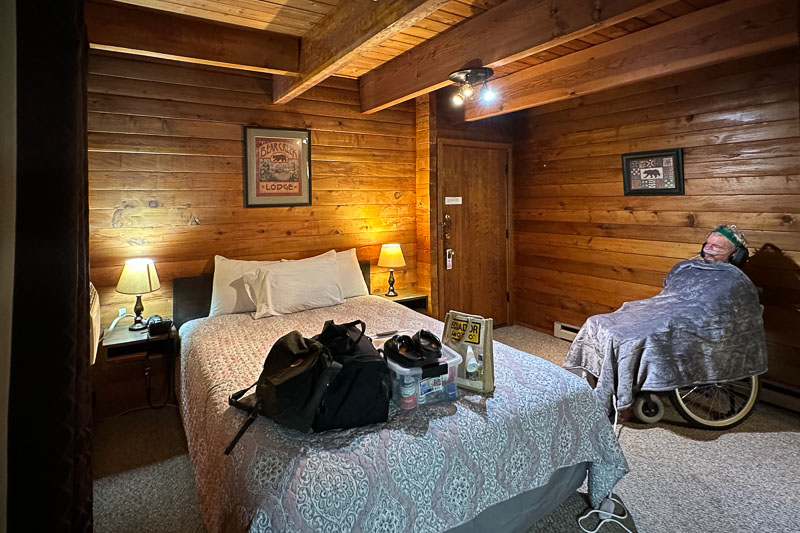 Tiffany Meadows is too far from Seattle for a day trip so we booked a room at the
Mazama Inn +, a place we
have not tried before because we usually stay at the Mazama Ranch House +. I do not recall why we did not stay at
the Ranch House, or even in Winthrop, but the Inn worked out well for us and the price was
reasonable. At least that is how I remember it as I write about it now, six months later and
without the benefit of Google's timeline since location tracking on my phone was apparently turned
off during the second half of June. Wait, I just checked and we actually did stay in Winthrop,
at The Virginian +.
It would be after our visit to Hart's Pass in mid-September to
Tiffany Meadows is too far from Seattle for a day trip so we booked a room at the
Mazama Inn +, a place we
have not tried before because we usually stay at the Mazama Ranch House +. I do not recall why we did not stay at
the Ranch House, or even in Winthrop, but the Inn worked out well for us and the price was
reasonable. At least that is how I remember it as I write about it now, six months later and
without the benefit of Google's timeline since location tracking on my phone was apparently turned
off during the second half of June. Wait, I just checked and we actually did stay in Winthrop,
at The Virginian +.
It would be after our visit to Hart's Pass in mid-September to see hear Boreal Owls that
we would stay at the Inn at Mazama. As at the Inn, our room at The Virginian was panelled with pine
and un-memorably comfortable
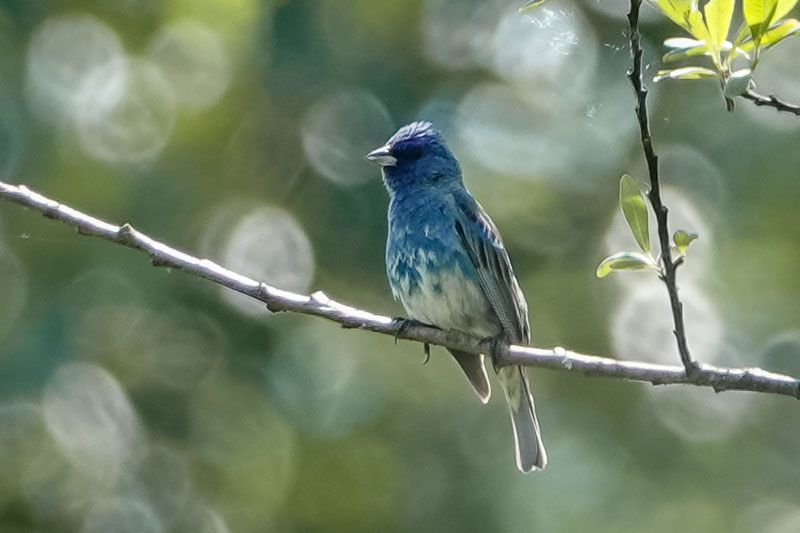
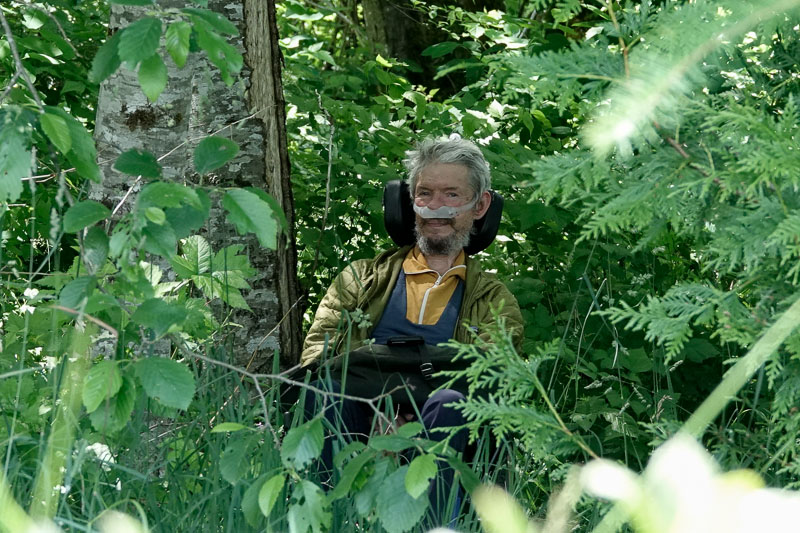
 Maxine chased the Indigo Bunting a day or two before us and reported that it was singing about a half
mile down a fisherman's trail from the parking lot at the Marblemount boat launch L+. We found the trail to be wide and
generally smooth singletrack and the bird to be singing from the tops of young firs and alders in a
large meadow along the trail. The song was distinctive but not enough different from nearby Lazuli
Buntings that we were willing to count it without visual confirmation so Darchelle parked me along
the trail before tackling the tall grass in a quest for photos. She was gone a long time but when
the bird returned and perched right over my head I figured she would not be far behind. She had
still not obtained a satisfactory photo so she and another birder who had in the meantime joined me
resumed their pursuit of the bunting while I continued to monitor the situation.
Maxine chased the Indigo Bunting a day or two before us and reported that it was singing about a half
mile down a fisherman's trail from the parking lot at the Marblemount boat launch L+. We found the trail to be wide and
generally smooth singletrack and the bird to be singing from the tops of young firs and alders in a
large meadow along the trail. The song was distinctive but not enough different from nearby Lazuli
Buntings that we were willing to count it without visual confirmation so Darchelle parked me along
the trail before tackling the tall grass in a quest for photos. She was gone a long time but when
the bird returned and perched right over my head I figured she would not be far behind. She had
still not obtained a satisfactory photo so she and another birder who had in the meantime joined me
resumed their pursuit of the bunting while I continued to monitor the situation.
On the way back to the car we paused to ponder the mystery of water gliding over the bleached cobbles of a pellucid tributary of the Skagit. Solids I can understand, their interlocking atoms obstructing intrusion of alien matter and particulate energy alike. Gasses I can imagine, their dancing molecules cloaked with invisibility yet courteously allowing strangers to pass unimpeded. Liquids though I cannot fathom. Themselves formless, they depend on gravity, constraining solids and occasionally inertia to loan them a shape which, once borrowed, is immediately abandoned in favor of another. They invite piecemeal intrusion, welcoming solid and gas alike into solution while vigorously resisting unanticipated penetration by either one. They fall, they flow, they seep, they percolate; resisting partition they (I'm thinking particularly of water now) persistently coalesce into a single massive individual extending from the depths of ocean and earth to the tops of the tallest trees and the trickles of the smallest alpine rivulets. Of that enormous Water, our tributary is just one uninterrupted yet perpetually moving part. But I digress.
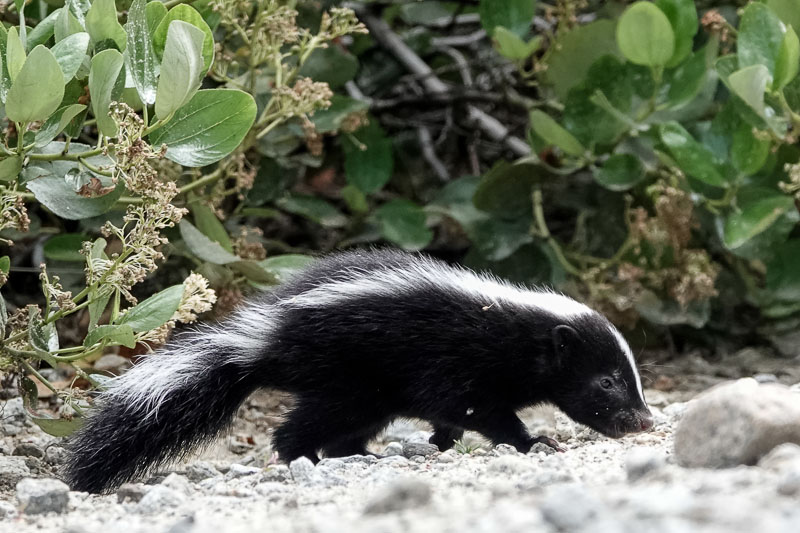

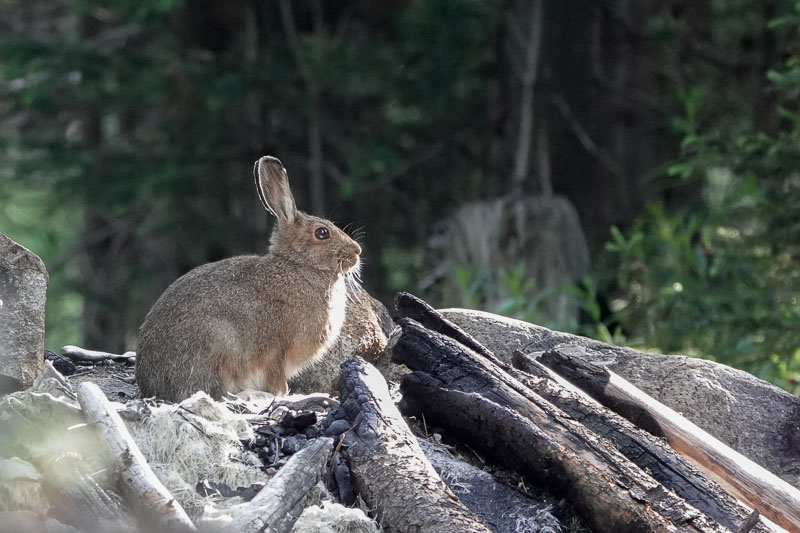 Five hours later we crested Freezout Pass L+ and resumed birdwatching. The long drive up from Winthrop
had not seemed quite as long as usual. The potholes pockmarking the paved portion had not seemed as
predatory and the rocks interrupting the roadbed below the pass had not seemed as rugged. As on
past trips Rogers Lake failed to produce a Spruce Grouse though we did encounter an interesting
mammal on our way up - a little skunk. It was cute, at least at a distance. Something about its
eyes, not to mention its upraised tail, rendered it less cute at close range. Cuter than the skunklet
was the Snowshoe Hare perched on top of an old campfire ring near Rogers Lake.
Five hours later we crested Freezout Pass L+ and resumed birdwatching. The long drive up from Winthrop
had not seemed quite as long as usual. The potholes pockmarking the paved portion had not seemed as
predatory and the rocks interrupting the roadbed below the pass had not seemed as rugged. As on
past trips Rogers Lake failed to produce a Spruce Grouse though we did encounter an interesting
mammal on our way up - a little skunk. It was cute, at least at a distance. Something about its
eyes, not to mention its upraised tail, rendered it less cute at close range. Cuter than the skunklet
was the Snowshoe Hare perched on top of an old campfire ring near Rogers Lake.
About two miles north of Freezout Pass where FR 39 passes through a mature stand of Lodgepole Pine we stopped to look for Boreal Chickadees. We had them at that exact spot in 2020 and about a quarter mile up the road last year. This year they called from back in the trees in response to our playback but did not come in for photos. What did come in, but not for photos, was an American Goshawk. It rocketed across the road about 100 feet ahead of us, sailed down a semi-open gully to our left and was gone. I shouted when I saw it and Darchelle caught a glimpse of the big blue-gray bird before it disappeared. "That was no raven!" we agreed.
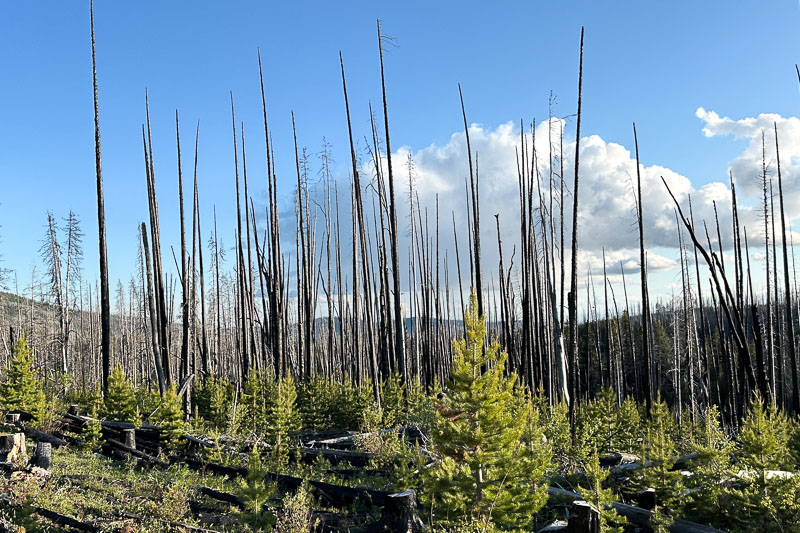
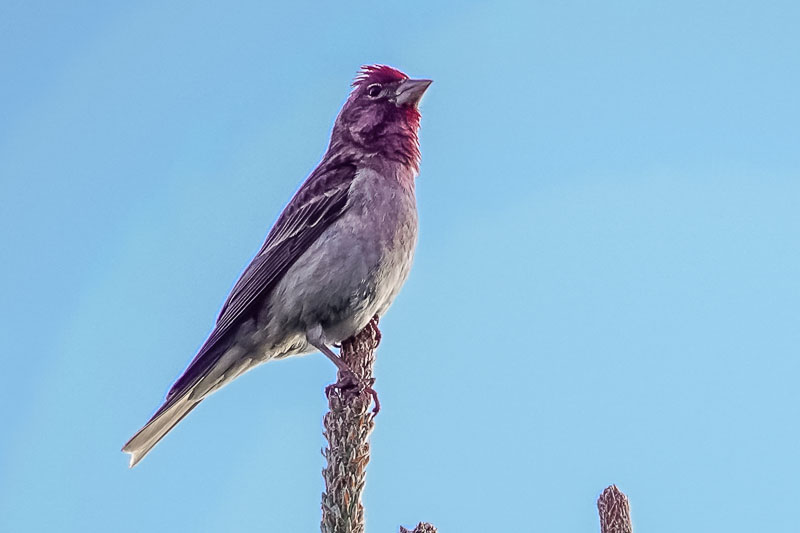 We continued out to the height of land past Tiffany Meadows campground where, in the distance
somewhere down in the burn, we thought we might have heard a Northern Hawk Owl calling. Darchelle
wanted to go look for it but I was unwilling to let her wander off into the burn alone so close to
sunset with no cell signal so we settled for telling Liam about it, since we knew he would be coming
up to look for the chickadees in a few days. He did come up and found both the chickadees and the
goshawk but I don't think he looked for the owl.
We continued out to the height of land past Tiffany Meadows campground where, in the distance
somewhere down in the burn, we thought we might have heard a Northern Hawk Owl calling. Darchelle
wanted to go look for it but I was unwilling to let her wander off into the burn alone so close to
sunset with no cell signal so we settled for telling Liam about it, since we knew he would be coming
up to look for the chickadees in a few days. He did come up and found both the chickadees and the
goshawk but I don't think he looked for the owl.
Of the resident land birds we can reasonably expect to see in Washington this year, we are missing only three - Spruce Grouse, American Goshawk and Boreal Chickadee. All three can be found along a one mile stretch of forest road between Freezout Pass and Tiffany Meadows in Okanogan County north of Winthrop. Knowing we would be fortunate to find even one of those species, we headed up there today anyhow on an outing made more appealing by the prospect of picking up the Indigo Bunting which Joel B-P discovered a few days ago in Marblemount.

Our room at The Virginian, Winthrop

Indigo Bunting, Marblemount

Watching the Indigo Bunting, Marblemount

Indigo Bunting, Marblemount
On the way back to the car we paused to ponder the mystery of water gliding over the bleached cobbles of a pellucid tributary of the Skagit. Solids I can understand, their interlocking atoms obstructing intrusion of alien matter and particulate energy alike. Gasses I can imagine, their dancing molecules cloaked with invisibility yet courteously allowing strangers to pass unimpeded. Liquids though I cannot fathom. Themselves formless, they depend on gravity, constraining solids and occasionally inertia to loan them a shape which, once borrowed, is immediately abandoned in favor of another. They invite piecemeal intrusion, welcoming solid and gas alike into solution while vigorously resisting unanticipated penetration by either one. They fall, they flow, they seep, they percolate; resisting partition they (I'm thinking particularly of water now) persistently coalesce into a single massive individual extending from the depths of ocean and earth to the tops of the tallest trees and the trickles of the smallest alpine rivulets. Of that enormous Water, our tributary is just one uninterrupted yet perpetually moving part. But I digress.

Striped Skunk, FR 39 near Rogers Lake

Striped Skunk, FR 39 near Rogers Lake

Snowshoe Hare, Rogers Lake
About two miles north of Freezout Pass where FR 39 passes through a mature stand of Lodgepole Pine we stopped to look for Boreal Chickadees. We had them at that exact spot in 2020 and about a quarter mile up the road last year. This year they called from back in the trees in response to our playback but did not come in for photos. What did come in, but not for photos, was an American Goshawk. It rocketed across the road about 100 feet ahead of us, sailed down a semi-open gully to our left and was gone. I shouted when I saw it and Darchelle caught a glimpse of the big blue-gray bird before it disappeared. "That was no raven!" we agreed.

Tripod Burn (2006) - Tiffany Meadows

Cassin's Finch, Tiffany Meadows
6/23/2023 Douglas & Chelan Counties (link to here)
With only one missing year bird left to chase on dry land between now and fall migration, we turned our attention to county birding today. As of this morning, Darchelle was 18 species short in Douglas County and 26 species short in Chelan. As of this evening, she has 104 in both. I already had over 100 species in both counties but padded my numbers a bit as well.
With only one missing year bird left to chase on dry land between now and fall migration, we turned our attention to county birding today. As of this morning, Darchelle was 18 species short in Douglas County and 26 species short in Chelan. As of this evening, she has 104 in both. I already had over 100 species in both counties but padded my numbers a bit as well.
Bounded by the Columbia River on the north and west and the Grand Coulee on the east,
Douglas County m+ consists mostly of a high plateau of Columbia River basalts deposited on top of
the Mesozoic crystalline rocks which are more prominently displayed to the north in Okanogan County.
Where soils, derived mostly from the glacial drift and loess, are deep enough the land is used for
non-irrigated production of wheat in the upland areas and apples along the Columbia River. Elsewhere
sagebrush and grasslands predominate although as with other shrub-steppe regions of the state,
cheatgrass-fueled range fires are converting sagebrush habitats to weedy grasslands.
Among birders the Waterville Plateau, the mostly upland area between Coulee City, Waterville and Bridgeport, is famous for raptors, chickens and owls. The Washington Birder County checklist +for Douglas County includes 319 species and eBird + shows 290 species on only 17K checklists. Most birders, like us, have visited almost exclusively in the winter and early spring, supplementing upland checklists with waterfowl on the river and passerines in the orchards. In the summer though, riparian areas along the river and a few nearby canyons, and bands of conifers along the margins of the plateau, are where the action is. We primarily visited the former, mostly around the town of Bridgeport, during our foray into the county today.
We did not find our destinations wheelchair-friendly. At Bridgeport Bar Wildlife Recreation Area L+ Darchelle walked in on the access road while I waited in the car outside the locked gate. Along Grange Road L+ we drove across a dry fallow field to access tractor trails by the river and brushy drainage ditch. At the Waterfront Park in Bridgeport L+ we could easily have wheeled around on paved trails but were able to find enough birds to put us over the top without even getting out of the car so we didn't.
Among birders the Waterville Plateau, the mostly upland area between Coulee City, Waterville and Bridgeport, is famous for raptors, chickens and owls. The Washington Birder County checklist +for Douglas County includes 319 species and eBird + shows 290 species on only 17K checklists. Most birders, like us, have visited almost exclusively in the winter and early spring, supplementing upland checklists with waterfowl on the river and passerines in the orchards. In the summer though, riparian areas along the river and a few nearby canyons, and bands of conifers along the margins of the plateau, are where the action is. We primarily visited the former, mostly around the town of Bridgeport, during our foray into the county today.
We did not find our destinations wheelchair-friendly. At Bridgeport Bar Wildlife Recreation Area L+ Darchelle walked in on the access road while I waited in the car outside the locked gate. Along Grange Road L+ we drove across a dry fallow field to access tractor trails by the river and brushy drainage ditch. At the Waterfront Park in Bridgeport L+ we could easily have wheeled around on paved trails but were able to find enough birds to put us over the top without even getting out of the car so we didn't.
Chelan County m+ reaches from the Cascade Crest to the Columbia River between the North
Cascades Highway at Washington Pass and Highway 97 at Swauk Pass north of Ellensburg. That's a
lot of scenery! Hikers love it; birders do too. The Washington Birder County checklist +for Chelan County boasts
320 species and eBird + shows 299 species on 59K checklists.
We found Chelan County more challenging than Douglas County, in part because most of our prior birding in the county had also been during the summer. It took us almost eight hours and six stops in a variety of habitats, mostly targeting individual species which we knew we needed, to reach our goal.


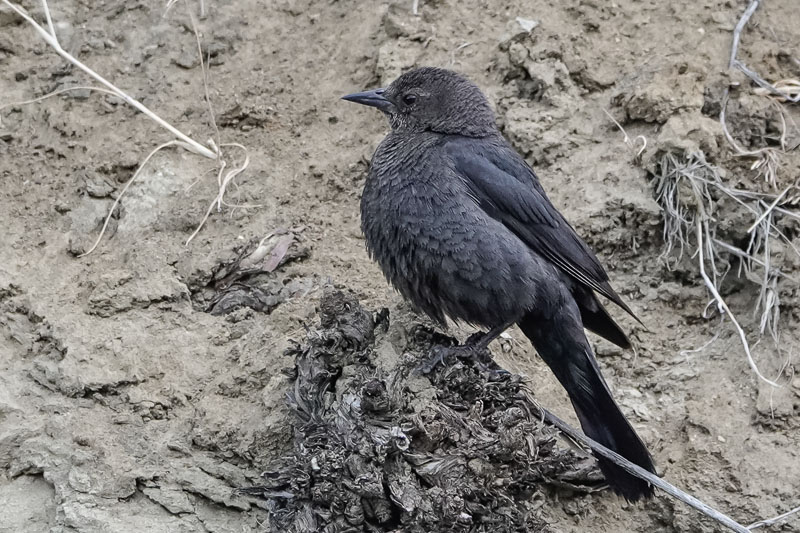 In Wenatchee we visited
Walla Walla Point L+, a large city park along the river and Saddle Rock City Park L+, a natural area in the steep arid hills
southwest of the city. I don't recall which species we were looking for but I do recall that we
did not find them in either location, though we nonetheless added new birds in both despite the
warm and breezy conditions. A few miles up the Wenatchee River at a boater put-in L+ in the town of Monitor we were able to access a
strip of riparian habitat along the river and procure a few more county birds. The Bullock's Oriole
which Darchelle photographed there was not one of them; we had seen our first one for the county at
Saddle Rock Park twenty minutes earlier.
In Wenatchee we visited
Walla Walla Point L+, a large city park along the river and Saddle Rock City Park L+, a natural area in the steep arid hills
southwest of the city. I don't recall which species we were looking for but I do recall that we
did not find them in either location, though we nonetheless added new birds in both despite the
warm and breezy conditions. A few miles up the Wenatchee River at a boater put-in L+ in the town of Monitor we were able to access a
strip of riparian habitat along the river and procure a few more county birds. The Bullock's Oriole
which Darchelle photographed there was not one of them; we had seen our first one for the county at
Saddle Rock Park twenty minutes earlier.
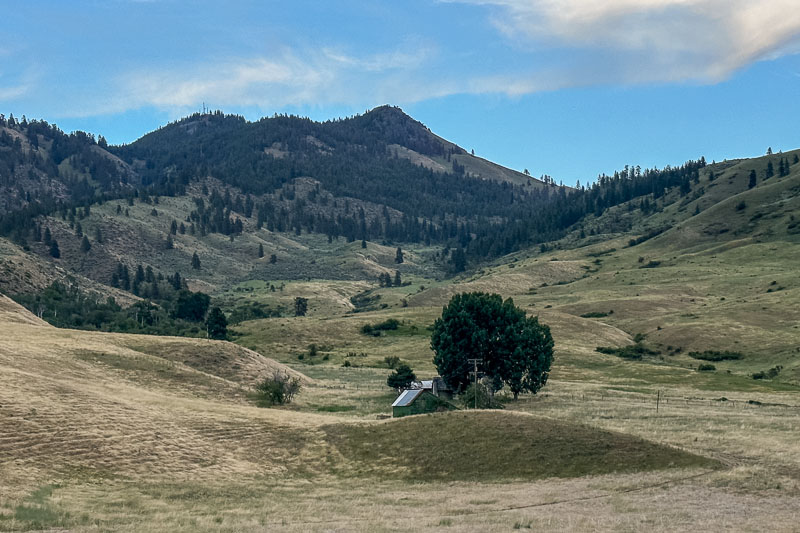

 Nahahum Canyon L+
across the river from the town of Cashmere was a new location for us. It hosts an appealing mix of
hillside meadows and brushy slopes with scattered firs, with riparian thickets in the lower canyon
and coniferous forest on the surrounding ridges. We drove about three miles up to the head of the
valley. A recent rain shower had saturated the dirt surface of the steep upper section of the road
leaving it a bit muddy. We had no difficulty on the way up but the descent was very slippery with
nothing but a few flowers to keep us from sliding right off the edge. The first few turns were
nail-biters.
Nahahum Canyon L+
across the river from the town of Cashmere was a new location for us. It hosts an appealing mix of
hillside meadows and brushy slopes with scattered firs, with riparian thickets in the lower canyon
and coniferous forest on the surrounding ridges. We drove about three miles up to the head of the
valley. A recent rain shower had saturated the dirt surface of the steep upper section of the road
leaving it a bit muddy. We had no difficulty on the way up but the descent was very slippery with
nothing but a few flowers to keep us from sliding right off the edge. The first few turns were
nail-biters.
The Chat and Blackbird were both new for the county. We had been wondering all afternoon where all the Brewer's Blackbirds were. Apparently they were all in Nahahum Canyon.
We found Chelan County more challenging than Douglas County, in part because most of our prior birding in the county had also been during the summer. It took us almost eight hours and six stops in a variety of habitats, mostly targeting individual species which we knew we needed, to reach our goal.

Saddle Rock City Park, Wenatchee

Bullock's Oriole, Monitor

Brewer's Blackbird, Nahahum Canyon

View up-valley, Nahahum Canyon

Yellow-breasted Chat, Nahahum Canyon

View down-valley, Nahahum Canyon
The Chat and Blackbird were both new for the county. We had been wondering all afternoon where all the Brewer's Blackbirds were. Apparently they were all in Nahahum Canyon.
6/28/2023 Dusky-capped Flycatcher (link to here)
We haven't done much birdwatching in the past week, though we did run up to Sedro Wooley yesterday afternoon to chase a suspected Dusky-capped Flycatcher, initially reported as an Ash-throated. The bird was first discovered the previous morning but the photos in the checklist showed a Myiarchus too yellow below to be an Ash-throated so Joel B-P drove out there first in the morning and heard the high-pitched descending calls of a Dusky-capped but was unable to spot the bird in the dense foliage of the willows and alders from which the calls appeared to be emanating. He was still looking for it when we arrived around 7:30 PM. Elizabeth and Liam, who had first notified us about the sighting, had arrived about an hour before us and they, along with several other big names in Washington birding, had joined Joel in the unsuccessful effort to find the flycatcher. We visited in the parking lot for a few minutes before everyone else left except for Elizabeth and Liam, who stayed to help us search until sunset. I thought I heard. it at one point but Liam spotted a flycatcher in the same area and pronounced it a Willow. I still wonder if he was on the right bird because the call I heard was a better match for the rarer species. In any case, we drove home feeling ambivalent about the prospect of returning in the morning should Liam and Elizabeth, who were spending the night in order to search again at dawn, succeed in finding it. To my relief, they did not.
We haven't done much birdwatching in the past week, though we did run up to Sedro Wooley yesterday afternoon to chase a suspected Dusky-capped Flycatcher, initially reported as an Ash-throated. The bird was first discovered the previous morning but the photos in the checklist showed a Myiarchus too yellow below to be an Ash-throated so Joel B-P drove out there first in the morning and heard the high-pitched descending calls of a Dusky-capped but was unable to spot the bird in the dense foliage of the willows and alders from which the calls appeared to be emanating. He was still looking for it when we arrived around 7:30 PM. Elizabeth and Liam, who had first notified us about the sighting, had arrived about an hour before us and they, along with several other big names in Washington birding, had joined Joel in the unsuccessful effort to find the flycatcher. We visited in the parking lot for a few minutes before everyone else left except for Elizabeth and Liam, who stayed to help us search until sunset. I thought I heard. it at one point but Liam spotted a flycatcher in the same area and pronounced it a Willow. I still wonder if he was on the right bird because the call I heard was a better match for the rarer species. In any case, we drove home feeling ambivalent about the prospect of returning in the morning should Liam and Elizabeth, who were spending the night in order to search again at dawn, succeed in finding it. To my relief, they did not.
6/30/2023 Packwood (link to here)
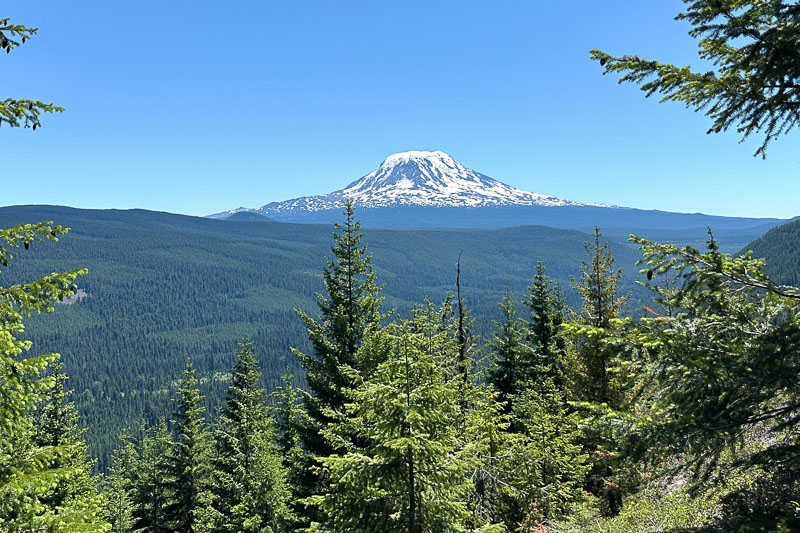
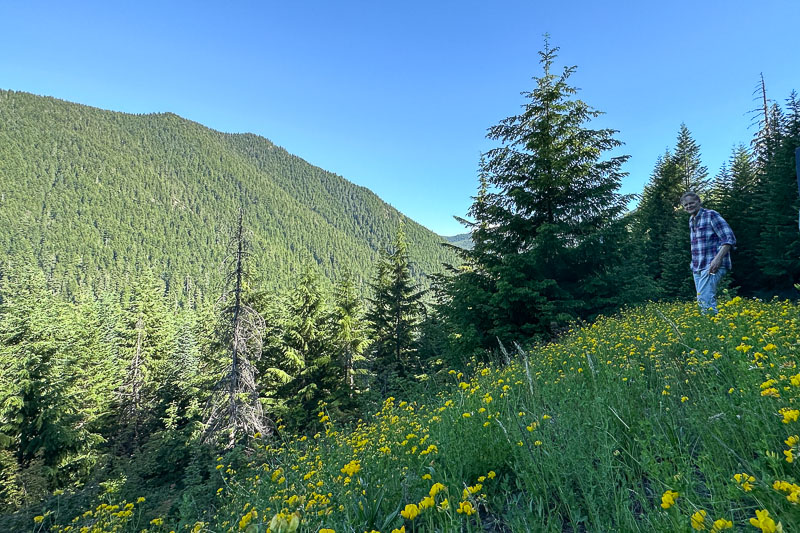
 We drove down to Packwood this morning to go birdwatching in the mountains south of town and
successfully picked up the 2 species Darchelle needed to put her securely over 100 in Lewis County.
The sun was warm, the sky blue and the air clear, affording beautiful views of Mount Adams from the
upper reaches of the North Fork Cispus River drainage. That valley still has quite a bit of a old
growth forest, mostly Western Hemlock, Douglas Fir and Pacific Silver Fir, and was one of the last
strongholds of Spotted Owls in the state. Unfortunately recent surveys indicate that the owls may no longer being present.
Songbirds were mostly silent, perhaps because we did not get up there until after 1PM, but
butterflies, particularly Tiger Swallowtails, seemed more common than usual, dancing in the sunlight
as they defended their patches of Cow-Parsnip (Heracleum maximum) and Mountain Golden-Pea?
(Thermopsis montana) along the roadsides.
We drove down to Packwood this morning to go birdwatching in the mountains south of town and
successfully picked up the 2 species Darchelle needed to put her securely over 100 in Lewis County.
The sun was warm, the sky blue and the air clear, affording beautiful views of Mount Adams from the
upper reaches of the North Fork Cispus River drainage. That valley still has quite a bit of a old
growth forest, mostly Western Hemlock, Douglas Fir and Pacific Silver Fir, and was one of the last
strongholds of Spotted Owls in the state. Unfortunately recent surveys indicate that the owls may no longer being present.
Songbirds were mostly silent, perhaps because we did not get up there until after 1PM, but
butterflies, particularly Tiger Swallowtails, seemed more common than usual, dancing in the sunlight
as they defended their patches of Cow-Parsnip (Heracleum maximum) and Mountain Golden-Pea?
(Thermopsis montana) along the roadsides.
Because we had anticipated returning to town late in the afternoon, we had booked a room at the Cowlitz River Lodge +. Although pricey at $200 the room was clean and quiet, but for me the toilet was inaccessible, the bed too soft and the pillow too hard. We've had better luck at their sister property the Crest Trail Lodge + but unfortunately there was no room at that inn.

Mount Adams from FR 22, Packwood

FR 22, Packwood

Mountain Golden-Pea (Thermopsis montana), Packwood
Because we had anticipated returning to town late in the afternoon, we had booked a room at the Cowlitz River Lodge +. Although pricey at $200 the room was clean and quiet, but for me the toilet was inaccessible, the bed too soft and the pillow too hard. We've had better luck at their sister property the Crest Trail Lodge + but unfortunately there was no room at that inn.
We conclude the month with 90280 miles on the car after spending 15 days in the field and 9 nights
away from home, not counting three nights on a family vacation on Orcas Island. Having worked hard
during June to make up for being out of the state during most of the spring migration, we end the
month with 308 species in Washington for the first half of this year. A year ago we had 330 but
based on my numbers over the past decade, we are still on track to reach 350 for the full year. We
are on track to exceed 100 in every county as well; the following table shows where Darchelle and I
respectively stand at this point. Darchelle has completed 9 of the 18 she needed as of the
beginning of the year and I have have completed 3 of the 9 I needed.
Note: Just over two weeks from now we will have finished the rest of our incomplete counties.
Note: Just over two weeks from now we will have finished the rest of our incomplete counties.
Here are my totals:
County
Species
This Year
Wahkiakum
78
13
Columbia
85
35
Mason
89
20
Franklin
97
35
Garfield
99
35
Ferry
100
-
Skamania
108
38
Asotin
113
15
Lewis
113
12
Cowlitz
114
37
Douglas
119
18
Here are Darchelle's totals:
County
Species
This Year
Ferry
63
-
Lincoln
69
24
Mason
70
31
Wahkiakum
78
13
Stevens
80
22
Garfield
82
37
Columbia
84
37
Franklin
89
33
Kitsap
99
2
Jefferson
101
-
San Juan
102
-
Skamania
102
46
Lewis
102
16
Whitman
103
26
Klickitat
103
15
Chelan
104
58
Douglas
104
20
Benton
105
9
Cowlitz
107
65
Asotin
110
15